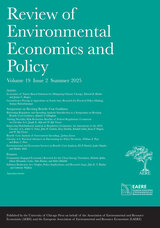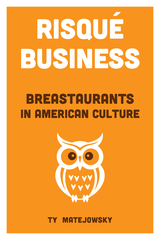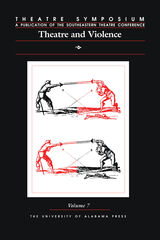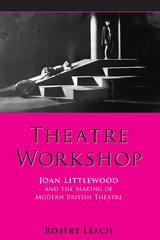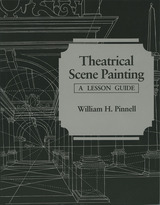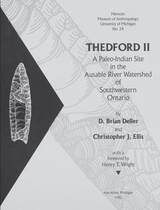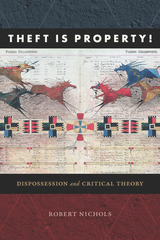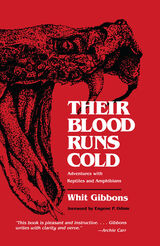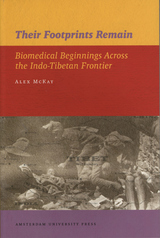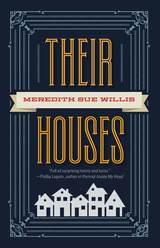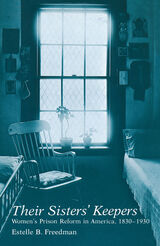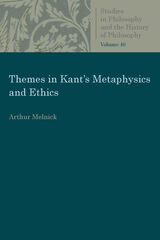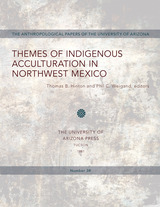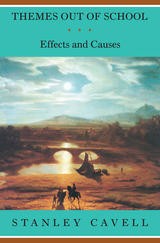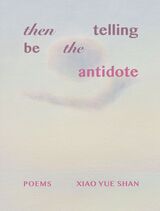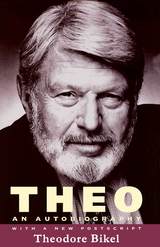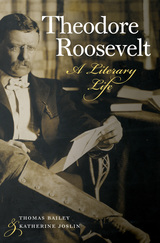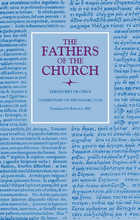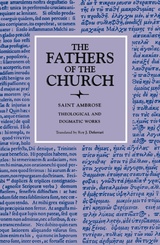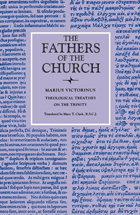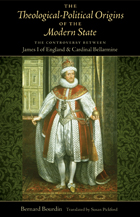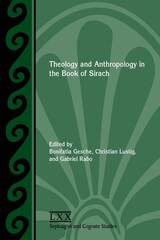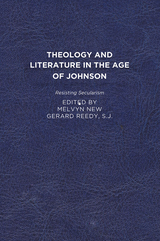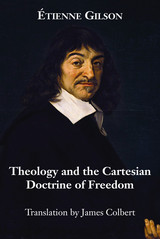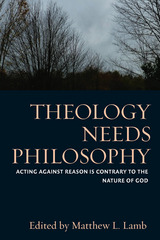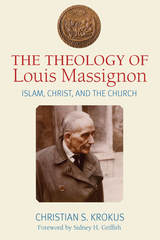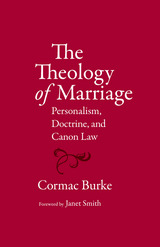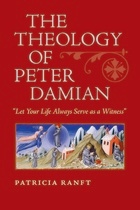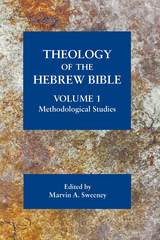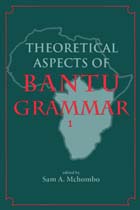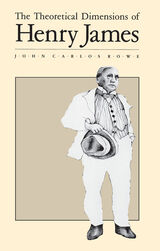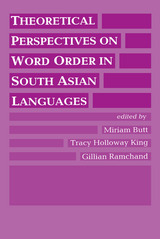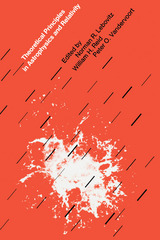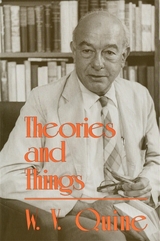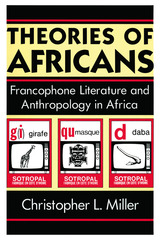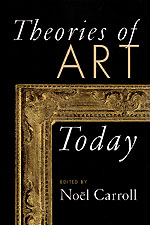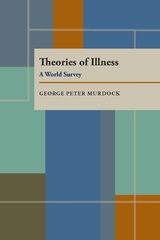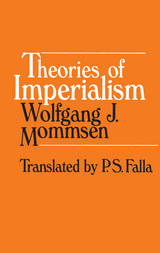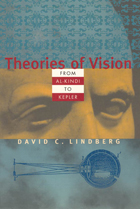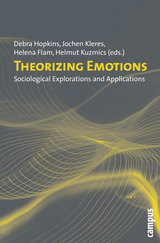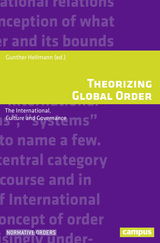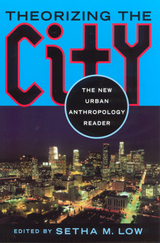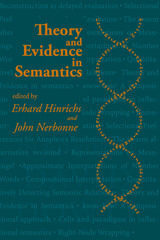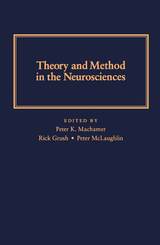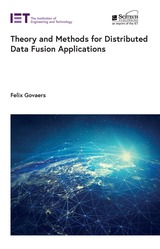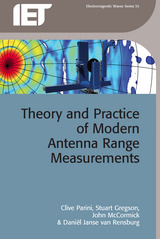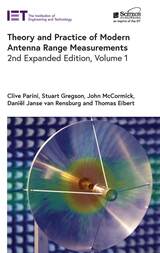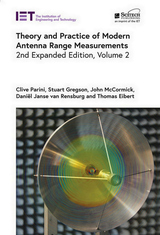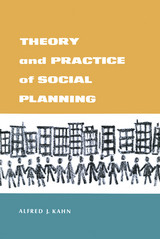Theatre Symposium, Vol. 32: Material Performance and Performing Objects
Keith Byron Kirk
University of Alabama Press, 2025 Theater Symposium, Volume 32 seeks to explore the collaborative interactions and ritual chains specific to performance during the collective reemergence into a hope filled post-COVID landscape. The contributors choose to engage this period of rebirth through an examination of the thriving and robust environment of material performance in all its facets. While vast in its diversity and by far the most popular aspect of object performance, puppetry serves as the guide into an even larger creative space of object performance styles and structures.
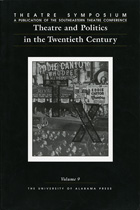 Theatre Symposium, Vol. 9: Theatre and Politics in the Twentieth Century
John C. Countryman
University of Alabama Press, 2001 This collection of essays explores how drama can teach political principles and entertain at the same time.
Political commentary is possible through "variety" theatre, this volume contends. Compiled from the April 2000 Theatre Symposium held on the campus of the University of Tennessee-Knoxville, this collection of essays
presents a compelling mix of theoretical and practical viewpoints from a broad diversity of scholars from around the country. What remains to be learned about the political objectives of Brecht's Lehrstriucke? What political power is resident in the satirical humor of Dario Fo's drama? What can we learn from Mordecai Gorelik's political/artistic philosophy that might inform contemporary practice? What was the impact of political theatre on Broadway between the wars? Is Thornton Wilder's Our Town the play we've always imagined it to be, or does it challenge the politics of its time? What is the role of theatre activism in raising consciousness about gender politics? These are only some of the questions addressed by this lively, informative discussion.
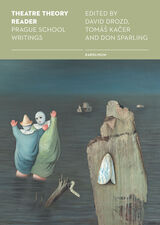 Theatre Theory Reader: Prague School Writings
Edited by David Drozd
Karolinum Press, 2017 The Theatre Theory Reader provides the first comprehensive and critical anthology of texts reflecting on the development of the theater theory of the Prague School—or Prague Linguistic Circle—beginning with early twentieth-century composer and aesthetician Otakar Zich. The majority of the thirty-eight texts date from the 1930s and early 1940s, the period when the Prague Linguistic Circle was most active as both a theoretical laboratory and a focal point for scholars, artists, and intellectuals. A substantial afterword places these writings in context, describing the emergence of the Prague School in an effort to promote a deeper understanding of its texts. Organized thematically and structurally rather than chronologically, the Theatre Theory Reader explores issues and themes in the study of the theater as an art form and as artistic practice. Just as the Prague School theorists viewed theory as a toolbox of approaches to theater analysis, this anthology should be considered a toolbox of analytic possibilities.
Theatre, Time and Temporality: Melting Clocks and Snapped Elastics
David Ian Rabey
Intellect Books, 2016 Theatre, Time and Temporality is the first book-length exploration of the subject of temporality within theater and performance. David Ian Rabey brings in sources ranging from medieval and Renaissance theater to contemporary performances—in addition to recent writings from physics, philosophy, and psychology—to analyze ways that time can be presented, communicated, and transformed in the theater. How do we experience time in theater, and how can that experience be altered or manipulated? Rabey’s analysis and exploration will spark discussion among students and scholars of drama, as well as among practicing performers and dramatic writers.
Theatre Workshop
Robert Leach
University of Exeter Press, 2006
Theatre Workshop: Joan Littlewood and the Making of Modern British Theatre is the first in-depth study of perhaps Britain’s most influential twentieth-century theatre company. The book sets the company’s aims and achievements in their social, political and theatrical contexts, and explores the elements which made its success so important.
Robert Leach has provided the definitive account in this first full-length study of Theatre Workshop and the methods of its director from 1945 to 1965, Joan Littlewood. His book provides the historical and political context needed by theatre studies students (both school and university), who frequently encounter Oh What a Lovely War as part of their courses.
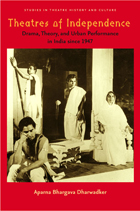 Theatres of Independence: Drama, Theory, and Urban Performance in India since 1947
Aparna Bhargava Dharwadker
University of Iowa Press, 2005 Theatres of Independence is the first comprehensive study of drama, theatre, and urban performance in post-independence India. Combining theatre history with theoretical analysis and literary interpretation, Aparna Dharwadker examines the unprecedented conditions for writing and performance that the experience of new nationhood created in a dozen major Indian languages and offers detailed discussions of the major plays, playwrights, directors, dramatic genres, and theories of drama that have made the contemporary Indian stage a vital part of postcolonial and world theatre.
The first part of Dharwadker’s study deals with the new dramatic canon that emerged after 1950 and the variety of ways in which plays are written, produced, translated, circulated, and received in a multilingual national culture. The second part traces the formation of significant postcolonial dramatic genres from their origins in myth, history, folk narrative, sociopolitical experience, and the intertextual connections between Indian, European, British, and American drama. The book’s ten appendixes collect extensive documentation of the work of leading playwrights and directors, as well as a record of the contemporary multilingual performance histories of major Indian, Western, and non-Western plays from all periods and genres. Treating drama and theatre as strategically interrelated activities, the study makes post-independence Indian theatre visible as a multifaceted critical subject to scholars of modern drama, comparative theatre, theatre history, and the new national and postcolonial literatures.
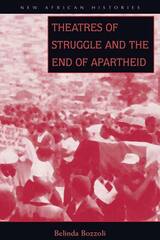 Theatres of Struggle and the End of Apartheid
Belinda Bozzoli
Ohio University Press, 2004 A compelling study of the origins and trajectory of one of the legendary black uprisings against apartheid, Theatres of Struggle and the End of Apartheid draws on insights gained from the literature on collective action and social movements. It delves into the Alexandra Rebellion of 1986 to reveal its inner workings. Belinda Bozzoli’s aim is to examine how the residents of Alexandra, a poverty-stricken segregated township in Johannesburg, manipulated and overturned the meanings of space, time, and power in their sequestered world. She explains how they used political theater to convey, stage, and dramatize their struggle and how young and old residents generated differing ideologies and tactics, giving rise to a distinct form of generational politics. Theatres of Struggle and the End of Apartheid asks the reader to enter into the world of the rebels and to confront the moral complexity and social duress they experienced as they invented new social forms and violently attacked old ones. It is an important study of collective action that will be of great interest to sociologists and to scholars of Africa, particularly to those interested in the antiapartheid struggle.
 Theatres of the Body: Dance and Discourse in Antebellum Philadelphia
Lynn Matluck Brooks
Temple University Press, 2025 Theatres of the Body is Lynn Matluck Brooks’ critical examination of danced stage productions in antebellum Philadelphia. Starting in the 1820s, Brooks explores visual art and social and theatrical dancing across different classes, focusing on the work of E. W. Clay. Continuing through the 1830s, she looks at pantomime ballets and blackface minstrelsy through a political lens, asking questions regarding citizenship, slavery, and freedom. At the time, the city boasted the largest number of native-born ballet dancers in the young nation. Philadelphia also became a creative home to blackface star T. D. Rice, who helped popularize that performance genre.
Reviewing print culture in the 1840s, Brooks shows how newspapers, magazines, and popular fiction provided documentation of dancing in Philadelphia as well as the responses of dance commentators, practitioners, and moralists. Theatres of the Body also considers the interplay of science with dance in the 1850s, which impacted both dance practices and reception.
Providing an expansive historiography of these significant contributions to dance in the United States, Brooks deepens our understanding of antebellum culture and history.
 Theatrical Consciousness: The Actor’s Mind in Russian Modernism
Alisa Ballard Lin
Northwestern University Press, 2025 Investigating late imperial Russian and early Soviet modernism’s reinvention of the actor In this wide-ranging study, Alisa Ballard Lin argues that Russian theatrical theory and practice contributed to a broad pre- and postrevolutionary discourse about the mind, profoundly reshaping concepts of consciousness, perception, identity, and the constitution of the subject. Theatrical Consciousness: The Actor’s Mind in Russian Modernism examines efforts in Russian theater—from around the turn of the century through the mid-1930s—to stimulate, train, imagine, and ultimately understand the actor’s, as well as the spectator’s, mind. Discussing key figures of the period, including Nikolai Evreinov, Konstantin Stanislavsky, Vsevolod Meyerhold, and Alexander Tairov, Lin identifies an underappreciated dimension of humanism within Russian modernism: a humanism that resisted the pressures of an increasingly technologized, industrialized, and politicized modernity that challenged the place of the human within it.
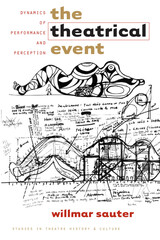 The Theatrical Event: Dynamics of Performance and Perception
Willmar Sauter
University of Iowa Press, 2000 The Theatrical Event discusses the objectives of theatre studies by focusing on the communicative encounter between performer and spectator—the theatrical event. A theatrical event includes the presentation of a performance and the attention of an audience; in this sense, every performance—on stage or in the street, historical or contemporary—that is watched by an audience is a theatrical event. The concept underlines the “eventness” of all encounters between performers and spectators. In the first part of the book, Willmar Sauter presents various models for the analysis of theatrical events, examining the relationship between performance and perception and the interaction between the performative event and its context. Using examples from ancient and recent theatre history and discussing traditional and nontraditional approaches to theatre theory, he builds a paradigmatic change in the concept of theatre. Constructs such as playing culture (as opposed to written culture), theatrical communication, theatricality, and theatre as a model of cultural event are brought into focus and their methodological advantages explored. The second part of the book uses the theoretical groundwork of the first part to enhance a variety of topics, including such legends as Sarah Bernhardt and other historical phenomena such as a Swedish Renaissance play, Strindberg's ideas on acting, the question of ethnicity in the political theatre of the 1930s, and critical writings on contemporary performances. Sauter examines how Robert Lepage's staging of A Dream Play is viewed by critics and scholars and analyzes Dario Fo's intercultural transfer to outdoor performances in Stockholm and the unusual sensationalism of Strindberg's Miss Julie.
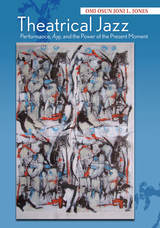 Theatrical Jazz: Performance, À??, and the Power of the Present Moment
Omi Osun Joni L. Jones
Ohio State University Press, 2015 Omi Osun Joni L. Jones provides the first full-length study of an artistic form, the theatrical jazz aesthetic, that draws on the jazz principles of ensemble—the break, the bridge, and the blue note. Theatrical Jazz: Performance, À??, and the Power of the Present Moment is a study of the use of jazz aesthetics in theatre as created by major practitioners of the form, giving particular attention to three innovative artists: Laurie Carlos, Daniel Alexander Jones, and Sharon Bridgforth.
Theatrical Jazz examines how artists are made and how artists make art. In charting their overlapping artistic genealogies, the book also discusses the work of veteran artists Aishah Rahman, Robbie McCauley, Sekou Sundiata, Ntozake Shange, and Erik Ehn, as well as the next generation of theatrical jazz innovators, Grisha Coleman, Walter Kitundu, Florinda Bryant, and Zell Miller III. Using autocritography as a primary methodology, the author draws on her role as performer, collaborator, audience/witness, and dramaturg in theatrical jazz, and her experiences with Yoruba spiritual traditions, to excavate the layers and nuances of this performance form. Jones’s use of performative writing, a blend of intellectual, artistic, and sensory experiences, allows scholars and students not only to read but also to “hear” the principles of theatrical jazz on the page.
Theatrical Reality: Space, Embodiment and Empathy in Performance
Campbell Edinborough
Intellect Books, 2016 Performance, dramaturgy, and scenography are often explored in isolation, but in Theatrical Reality, Campbell Edinborough describes their connectedness in order to investigate how the experience of reality is constructed and understood during performance. Drawing on sociological theory, cognitive psychology, and embodiment studies, Edinborough analyzes our seemingly paradoxical understanding of theatrical reality, guided by the contexts shaping relationships between performer, spectator, and performance space. Through a range of examples from theatre, dance, circus, and film, Theatrical Reality examines how the liminal spaces of performance foster specific ways of conceptualizing time, place, and reality.
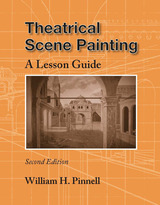 Theatrical Scene Painting: A Lesson Guide
William H. Pinnell
Southern Illinois University Press, 2008 Theatrical Scene Painting: A Lesson Guide, second edition, is a practical guide to scene painting for students and novices, as well as a reference for intermediate scene painters who wish to refresh or supplement their basic skills. Drawing on his extensive teaching and scene-painting experience, William H. Pinnell clarifies and expands on the lessons of the first edition, providing a detailed overview of the fundamentals of traditional scene painting. The guide not only covers the basic tools of the trade and various methods of creating texture on scenery but also includes more advanced techniques for scene making, beginning with stonework, woodwork, and wallpaper before moving on to the more intricate techniques of moldings, paneling, drapery, foliage, shiny metal, perspective illusions, scale transfers, scenic drops, and scrims. Pinnell also includes refinements and embellishments that can lead to the development of personal style without sacrificing the goal of realism and more advanced work. Alternative methods to achieve different effects are also featured. Theatrical Scene Painting: A Lesson Guide was the first book of its kind to provide clear step-by-step instructions in how to paint a wide variety of basic and advanced effects commonly needed for the theater. This new edition clarifies the origins of painting techniques and is supplemented with clearer step-by-step descriptions, new instructional photographs, and drawings that illustrate each major step. This edition also includes additional painting projects and their possible variations, a gallery of nineteen examples of professional scenic works, and an expanded glossary to eliminate confusion in terms. Useful to both self-taught artists and students, each lesson in the guide can be a stand-alone topic or can form the foundation for a student to build skills for increasingly complex techniques. The second edition of Theatrical Scene Painting provides many new essential scene painting projects in a clearer format, broadens the scope of the painting examples, and includes updated methods as well as new lessons. This clear and easily accessible guide gives students the ability to put together recognizable illusions.
Theatrical Scene Painting: A Lesson Guide
William H. Pinnell
Southern Illinois University Press, 1987
This handbook explains the techniques of traditional scene painting. A “how to” book for the novice, it shows the methods used in creating the illusion of three dimensions where only two exist. It provides a step-by-step explanation of each aspect of scene painting, using both color and black-and-white photographs for illustration.
Among the many illusions made possible through the magic of paint are stonework, wallpaper, woodwork, as well as mouldings, draperies, and foliage. To teach the beginner how to re-create reality through painted illusion, Pinnell emphasizes traditional scene painting, including basic tools, primary painting techniques, and methods for creating texture on scenery. He also illustrates refinements and embellishments that lead to more advanced work.
 The Theatricalists: Making Politics Appear
Theron Schmidt
Northwestern University Press, 2024 Examines how the politics of the theater can illuminate the theatricality of politics Theatricality is often dismissed as a distraction from “real” politics, as when cynical political gestures are derided as “pure theater” or “only theater.” But the artists and theater companies discussed in this book, including Back to Back Theatre, Tim Crouch, Rabih Mroué, Nature Theater of Oklahoma, and Christoph Schlingensief, take a different approach. Theron Schmidt argues that they represent a “theatricalist turn” that explores and tests the conditions of the theater itself. Across diverse contexts of political engagement, ranging from disability rights to representations of violence, these theatrical conditions are interconnected with political struggles, such as those over who is seen and heard, how labor is valued, and what counts as “political” in the first place. In a so-called post-political era, The Theatricalists argues that an examination of theater’s internal politics can expand our understanding of the theatricality of politics more broadly.
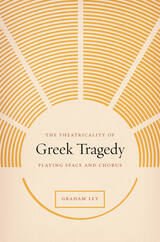 The Theatricality of Greek Tragedy: Playing Space and Chorus
Graham Ley
University of Chicago Press, 2007 Ancient Greek tragedy has been an inspiration to Western culture, but the way it was first performed has long remained in question. In The Theatricality of Greek Tragedy, Graham Ley provides an illuminating discussion of key issues relating to the use of the playing space and the nature of the chorus, offering a distinctive impression of the performance of Greek tragedy in the fifth century BCE.
Drawing on evidence from the surviving texts of tragedies by Aeschylus, Sophocles, and Euripides, Ley explains how scenes with actors were played in the open ground of the orchestra, often considered as exclusively the dancing place of the chorus. In reviewing what is known of the music and dance of Greek antiquity, Ley goes on to show that in the original productions the experience of the chorus—expressed in song and dance and in interaction with the characters—remained a vital characteristic in the performance of tragedy.
Combining detailed analysis with broader reflections about the nature of ancient Greek tragedy as an art form, this volume—supplemented with a series of illustrative drawings and diagrams—will be a necessary addition to the bookshelf of anyone interested in literature, theater, or classical studies.
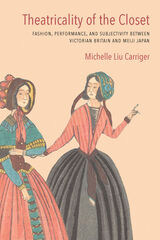 Theatricality of the Closet: Fashion, Performance, and Subjectivity between Victorian Britain and Meiji Japan
Michelle Liu Carriger
Northwestern University Press, 2023 A richly illustrated exploration of fashion and its capacity for generating controversy and constructing social and individual identities Clothing matters. This basic axiom is both common sense and, in another way, radical. It is from this starting point that Michelle Liu Carriger elucidates the interconnected ways in which gender, sexuality, class, and race are created by the everyday act of getting dressed. Theatricality of the Closet: Fashion, Performance, and Subjectivity between Victorian Britain and Meiji Japan examines fashion and clothing controversies of the nineteenth century, drawing on performance theory to reveal how the apparently superficial or frivolous deeply affects the creation of identity. By interrogating a set of seemingly disparate examples from the same period but widely distant settings—Victorian Britain and Meiji-era Japan—Carriger disentangles how small, local, ordinary practices became enmeshed in a global fabric of cultural and material surfaces following the opening of trade between these nations in 1850. This richly illustrated book presents an array of media, from conservative newspapers and tabloids to ukiyo-e and early photography, that locate dress as a site where the individual and the social are interwoven, whether in the 1860s and 1870s or the twenty-first century.
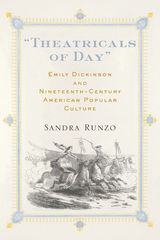 "Theatricals of Day": Emily Dickinson and Nineteenth-Century American Popular Culture
Sandra Runzo
University of Massachusetts Press, 2019 In her own private ways, Emily Dickinson participated in the popular entertainments of her time. On her piano, she performed popular musical numbers, many from the tradition of minstrelsy, and at theaters, she listened to famous musicians, including Jenny Lind and, likely, the Hutchinson Family Singers. In reading the Atlantic Monthly, the Springfield Republican, and Harper's, she kept up with the roiling conflicts over slavery and took in current fiction and verse. And, she enjoyed the occasional excursion to the traveling circus and appreciated the attractions of the dime museum. Whatever her aspirations were regarding participation in a public arena, the rich world of popular culture offered Dickinson a view of both the political and social struggles of her time and the amusements of her contemporaries.
“Theatricals of Day” explores how popular culture and entertainments are seen, heard, and felt in Dickinson's writing. In accessible prose, Sandra Runzo proposes that the presence of popular entertainment in Dickinson's life and work opens our eyes to new dimensions of the poems, illuminating the ways in which the poet was attentive to strife and conflict, to amusement, and to play.
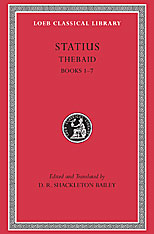 Thebaid, Volume I: Books 1–7
Statius
Harvard University Press, 2003 Fraternal strife.
Statius published his Thebaid in the last decade of the first century. This epic recounting the struggle between the two sons of Oedipus for the kingship of Thebes is his masterpiece, a stirring exploration of the passions of civil war. The extant portion of his unfinished Achilleid is strikingly different in tone: this second epic begins as a charming account of Achilles’ life.
Statius was raised in the Greek cultural milieu of the Bay of Naples, and his Greek literary education is reflected in his poetry. The political realities of Rome in the first century are also evident in the Thebaid, in representations of authoritarian power and the drive for domination. Shackleton Bailey’s new edition of the two epics, with a highly skillful translation, addresses a number of puzzles in the text and its interpretation and provides essential information on mythological and other references. Kathleen M. Coleman, Professor of Latin at Harvard University, contributes a survey of recent scholarship on Statius’ epics.
The new Loeb Classical Library edition of Statius is complete in three volumes.
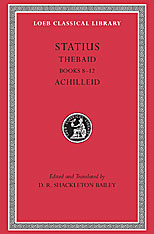 Thebaid, Volume II: Books 8–12. Achilleid
Statius
Harvard University Press, 2003 Fraternal strife, and the young Achilles.
Statius published his Thebaid in the last decade of the first century. This epic recounting the struggle between the two sons of Oedipus for the kingship of Thebes is his masterpiece, a stirring exploration of the passions of civil war. The extant portion of his unfinished Achilleid is strikingly different in tone: this second epic begins as a charming account of Achilles’ life.
Statius was raised in the Greek cultural milieu of the Bay of Naples, and his Greek literary education is reflected in his poetry. The political realities of Rome in the first century are also evident in the Thebaid, in representations of authoritarian power and the drive for domination. Shackleton Bailey’s new edition of the two epics, with a highly skillful translation, addresses a number of puzzles in the text and its interpretation and provides essential information on mythological and other references. Kathleen M. Coleman, Professor of Latin at Harvard University, contributes a survey of recent scholarship on Statius’ epics.
The new Loeb Classical Library edition of Statius is complete in three volumes.
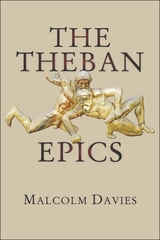 The Theban Epics
Malcolm Davies
Harvard University Press, 2014 In antiquity, the story of the failed assault of the Seven against Thebes ranked second only to the Trojan War. But whereas the latter was immortalized by Homer’s Iliad, the account of the former in the epic Thebais survives only in fragments preserved in later authors. The same is true of the Oedipodeia and Epigoni, which dealt respectively with events leading up to the Seven’s campaign and with the successful assault on the city in the next generation. The Thebais was probably the most important of the three—certainly more and longer fragments of it have survived—and it has been alleged that its recovery would tell us more about Homer than any comparable discovery.
Paradoxically, these fragments suggest very un-Homeric content and style (in particular its detail of the hero Tydeus forfeiting immortality by gnawing on the head of a dying enemy). The same is true of the epic Alcmaeonis, named after one of the Epigoni, whose few surviving fragments pullulate with un-Homeric features. Malcolm Davies provides the first full commentary on all four epics’ fragments. He attempts to set them in context and examines whether artistic depictions of the relevant myths can help reconstruct the lost epics’ contents.
The Theban Hegemony, 371-362 BC
John Buckler
Harvard University Press, 1980 The decade of Theban power in fourth-century Greece has not been the subject of a full study in this century. Mr. Buckler provides a totally new look at Theban diplomacy and politics. He examines, for the first time, the social and economic backgrounds of the leaders of Thebes during the period of its hegemony. He focuses attention also on local politics and on the constitution of the Boiotian Confederacy, the federal government created by Thebes in the 370s.
Of special interest is the author's recognition of the historical implications of topography. He has inspected the terrain of the battlefields and routes of communication; his accounts of military campaigns are thus well grounded and convincing. His contemporary photographs of major sites and topographical maps are valuable supplements to the text.
This study is a significant contribution to our knowledge of an important period of Greek history.
Theft Is Property!: Dispossession and Critical Theory
Robert Nichols
Duke University Press, 2020 Drawing on Indigenous peoples' struggles against settler colonialism, Theft Is Property! reconstructs the concept of dispossession as a means of explaining how shifting configurations of law, property, race, and rights have functioned as modes of governance, both historically and in the present. Through close analysis of arguments by Indigenous scholars and activists from the nineteenth century to the present, Robert Nichols argues that dispossession has come to name a unique recursive process whereby systematic theft is the mechanism by which property relations are generated. In so doing, Nichols also brings long-standing debates in anarchist, Black radical, feminist, Marxist, and postcolonial thought into direct conversation with the frequently overlooked intellectual contributions of Indigenous peoples.
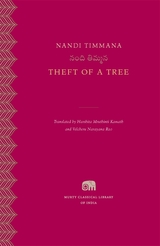 Theft of a Tree: A Tale by the Court Poet of the Vijayanagara Empire
Nandi Timmana
Harvard University Press, 2022 The first English translation of a thousand-year-old story of Krishna and his wife Satyabhama, retold by the most famous court poet of the Vijayanagara Empire.
Legend has it that the sixteenth-century Telugu poet Nandi Timmana composed Theft of a Tree, or Pārijātāpaharaṇamu, to help the wife of Krishnadevaraya, king of the south Indian Vijayanagara Empire, win back her husband’s affections. Timmana based his work on a popular millennium-old Krishna tale.
Theft of a Tree recounts how Krishna stole the wish-granting pārijāta tree from the garden of Indra, king of the gods. Krishna takes the tree to please his favorite wife, Satyabhama, who is upset when he gifts his chief queen a single divine flower. After battling Indra, he plants the pārijāta for Satyabhama—but she must perform a rite temporarily relinquishing it and her husband to enjoy endless happiness.
This is the first English translation of the poem, which prefigures the modern Telugu novel with its unprecedented narrative unity.
 Thefts of Relics in Italy: From Late Antiquity to the Central Middle Ages, 300–1150
Marco Papasidero
Amsterdam University Press, 2025 With the emergence of the cult of saints, their remains assumed a central role, becoming sources of miraculous events and healings. According to the accounts of their martyrdom, the bodies were initially removed immediately after death to protect them from destruction by the elements or animals. In the centuries that followed, particularly after the cessation of persecution, the possession of saints’ relics came to signify prestige for a church, monastery, or city. The phenomenon of relic theft (furta sacra) – attested throughout the whole medieval Europe – is therefore closely linked to the need to document and legitimise such thefts, thereby establishing the right of a specific religious or urban community to claim possession of a saint’s remains. Justifications, legitimations, ordeals and supernatural interventions are intricately woven into the narratives of hagiographers across the centuries. This book adopts an interdisciplinary approach to reconstruct the cultural history of relic theft within the specific context of Italy, from Late Antiquity through to the Central Middle Ages.
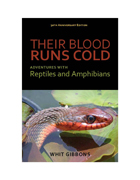 Their Blood Runs Cold: Adventures with Reptiles and Amphibians
Whit Gibbons
University of Alabama Press, 2013 Their Blood Runs Cold is entertaining, informative reading that not only enhances our understanding of a unique group of animals, but also provides genuine insight into the mind and character of a research scientist. Whit Gibbons possesses the rare talent of conveying the challenge and excitement of scientific inquiry. A research ecologist who specializes in the study of reptiles and amphibians, he gives accounts of work in the field that are as readable as good short stories. From the dangers of being chased by an angry rattlesnake to the exhilaration of discovering a previously undescribed species, Gibbons brings to life the everyday experiences of the herpetologist as he chases down lizards, turtles, snakes, alligators, salamanders, and frogs in their natural habitats. With essays like “Turtles May Be Slow but They’re 200 Million Years Ahead of Us” and “How to Catch an Alligator in One Uneasy Lesson,” Their Blood Runs Cold both entertains and informs. The thirtieth anniversary edition of Their Blood Runs Cold features a new prologue and epilogue, additions that address changes in the taxonomy and study of reptiles and amphibians that have occurred since the publication of the original edition and offer suggestions for further reading that highlight the explosion of interest in the topic.
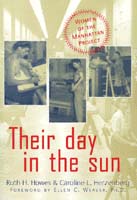 Their Day In The Sun
Ruth Howes
Temple University Press, 1999 The public perception of the making of the atomic bomb is yet an image of the dramatic efforts of a few brilliant male scientists. However, the Manhattan Project was not just the work of a few and it was not just in Los Alamos. It was, in fact, a sprawling research and industrial enterprise that spanned the country from Hanford in Washington State to Oak Ridge in Tennessee, and the Met labs in Illinois.
The Manhattan Project also included women in every capacity. During World War II the manpower shortages opened the laboratory doors to women and they embraced the opportunity to demonstrate that they, too, could do "creative science." Although women participated in all aspects of the Manhattan Project, their contributions are either omitted or only mentioned briefly in most histories of the project. It is this hidden story that is presented in Their Day in the Sun through interviews, written records, and photographs of the women who were physicists, chemists, mathematicians, biologists, and technicians in the labs.
Authors Ruth H. Howes and Caroline L. Herzenberg have uncovered accounts of the scientific problems the women helped solve as well as the opportunities and discrimination they faced. Their Day in the Sun describes their abrupt recruitment for the war effort and includes anecdotes about everyday life in these clandestine improvised communities. A chapter about what happened to the women after the war and about their attitudes now, so many years later, toward the work they did on the bomb is included.
 Their Day In The Sun: Women Of The Manhattan Project
Ruth H. Howes
Temple University Press, 2003 The public perception of the making of the atomic bomb is yet an image of the dramatic efforts of a few brilliant male scientists. However, the Manhattan Project was not just the work of a few and it was not just in Los Alamos. It was, in fact, a sprawling research and industrial enterprise that spanned the country from Hanford in Washington State to Oak Ridge in Tennessee, and the Met labs in Illinois. The Manhattan Project also included women in every capacity. During World War II the manpower shortages opened the laboratory doors to women and they embraced the opportunity to demonstrate that they, too, could do "creative science." Although women participated in all aspects of the Manhattan Project, their contributions are either omitted or only mentioned briefly in most histories of the project. It is this hidden story that is presented in Their Day in the Sun through interviews, written records, and photographs of the women who were physicists, chemists, mathematicians, biologists, and technicians in the labs. Authors Ruth H. Howes and Caroline L. Herzenberg have uncovered accounts of the scientific problems the women helped solve as well as the opportunities and discrimination they faced. Their Day in the Sun describes their abrupt recruitment for the war effort and includes anecdotes about everyday life in these clandestine improvised communities. A chapter about what happened to the women after the war and about their attitudes now, so many years later, toward the work they did on the bomb is included.
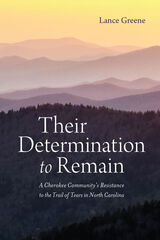 Their Determination to Remain: A Cherokee Community's Resistance to the Trail of Tears in North Carolina
Lance Greene
University of Alabama Press, 2023 The remarkable story of a North Carolina Cherokee community who avoided forced removal on the Trail of Tears
During the 1838 forced Cherokee removal by the US government, a number of close-knit Cherokee communities in the Southern Appalachian Mountains refused to relinquish their homelands, towns, and way of life. Using a variety of tactics, hundreds of Cherokees avoided the encroaching US Army and remained in the region.
In his book Their Determination to Remain: A Cherokee Community’s Resistance to the Trail of Tears in North Carolina, Lance Greene explores the lives of wealthy plantation owners Betty and John Welch who lived on the southwestern edge of the Cherokee Nation. John was Cherokee and Betty was White. Although few Cherokees in the region participated in slavery, the Welches held nine African Americans in bondage.
During removal, the Welches assisted roughly 100 Cherokees hiding in the steep mountains. Afterward, they provided land for these Cherokees to rebuild a new community, Welch’s Town. Betty became a wealthy and powerful plantation mistress because her husband could no longer own land. Members of Welch’s Town experienced a transitional period in which they had no formal tribal government or clear citizenship yet felt secure enough to reestablish a townhouse, stickball fields, and dance grounds.
Greene’s innovative study uses an interdisciplinary approach, incorporating historical narrative and archaeological data, to examine how and why the Welches and members of Welch’s Town avoided expulsion and reestablished their ways of life in the midst of a growing White population who resented a continued Cherokee presence. The Welch strategy included Betty’s leadership in demonstrating outwardly their participation in modern Western lifestyles, including enslavement, as John maintained a hidden space—within the boundaries of their land—for the continuation of traditional Cherokee cultural practices. Their Determination to Remain explores the complexities of race and gender in this region of the antebellum South and the real impacts of racism on the community.
Their Footprints Remain: Biomedical Beginnings Across the Indo-Tibetan Frontier
Alex McKay
Amsterdam University Press, 2008
By the end of the 19th century, British imperial medical officers and Christian medical missionaries had introduced Western medicine to Tibet, Sikkim, and Bhutan. Their Footprints Remain uses archival sources, personal letters, diaries, and oral sources in order to tell the fascinating story of how this once-new medical system became imbedded in the Himalayas. Of interest to anyone with an interest in medical history and anthropology, as well as the Himalayan world, this volume not only identifies the individuals involved and describes how they helped to spread this form of imperialist medicine, but also discusses its reception by a local people whose own medical practices were based on an entirely different understanding of the world.
Their Houses
MEREDITH S. WILLIS
West Virginia University Press, 2018 As children, two sisters make homes for their toys out of matchboxes and shoeboxes, trying to create safe places after the loss of their mother to psychosis. Grace, a schoolteacher married to a doctor, appears to have a conventional life but has a breakdown during a undesired move her beloved cottage to another house. Dinah has married a once self-ordained preacher with a troubled past and tries to keep her children safely separate from the world. Meanwhile, a childhood friend is linked to a militia’s abortive attempt to blow up the FBI’s fingerprint records facility in West Virginia, and later builds an isolated survivalist compound in the mountains. These three adults, closely bonded in childhood, are reunited on this acreage once owned by a white supremacist group, where they discover in various ways that there is no final protection, no matter how hard they strive to find it or make it.
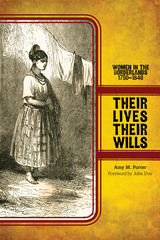 Their Lives, Their Wills: Women in the Borderlands, 1750-1846
Amy M. Porter
Texas Tech University Press, 2015 In 1815, in the Spanish settlement of San Antonio de Béxar, a dying widow named María Concepción de Estrada recorded her last will and testament. Estrada used her will to record her debts and credits, specify her property, leave her belongings to her children, make requests for her funeral arrangements, and secure her religious salvation.
Wills like Estrada’s reveal much about women’s lives in the late Spanish and Mexican colonial communities of Santa Fe, El Paso, San Antonio, Saltillo, and San Esteban de Nueva Tlaxcala in present-day northern Mexico. Using last wills and testaments as main sources, Amy M. Porter explores the ways in which these documents reveal details about religion, family, economics, and material culture. In addition, the wills speak loudly to the difficulties of frontier life, in which widowhood and child mortality were commonplace. Most importantly, information in the wills helps to explain the workings of the patriarchal system of Spanish and Mexican borderland communities, showing that gender role divisions were fluid in some respects. Supplemented by censuses, inventories, court cases, and travelers’ accounts, women’s wills paint a more complete picture of life in the borderlands than the previously male-dominated historiography of the region.
 Their Right to Speak: Women's Activism in the Indian and Slave Debates
Alisse Portnoy
Harvard University Press, 2005 When Alisse Portnoy recovered petitions from the early 1830s that nearly 1,500 women sent to the U.S. Congress to protest the forced removal of Native Americans in the South, she found the first instance of women's national, collective political activism in American history. In this groundbreaking study, Portnoy links antebellum Indian removal debates with crucial, simultaneous debates about African Americans--abolition of slavery and African colonization--revealing ways European American women negotiated prohibitions to make their voices heard.
Situating the debates within contemporary, competing ideas about race, religion, and nation, Portnoy examines the means by which women argued for a "right to speak" on national policy. Women's participation in the debates was constrained not only by gender but also by how these women--and the men with whom they lived and worshipped--imagined Native and African Americans as the objects of their advocacy and by what they believed were the most benevolent ways to aid the oppressed groups.
Cogently argued and engagingly written, this is the first study to fully integrate women's, Native American, and African American rights debates.
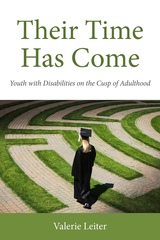 Their Time Has Come: Youth with Disabilities on the Cusp of Adulthood
Leiter, Valerie
Rutgers University Press, 2012 The lives of youth with disabilities have changed radically in the past fifty years. Youth who are coming of age right now are the first generation to receive educational services throughout childhood and adolescence. Disability policies have opened up opportunities to youth, and they have responded by getting higher levels of education than ever before. Yet many youth are being left behind, compared to their peers without disabilities. Youth with disabilities often still face major obstacles to independence. In Their Time Has Come, Valerie Leiter argues that there are crucial missing links between federal disability policies and the lives of young people. Youth and their parents struggle to gather information about the resources that disability policies have created, and youth are not typically prepared to use their disability rights effectively. Her argument is based on thorough examination of federal disability policy and interviews with young people with disabilities, their parents, and rehabilitation professionals. Attention is given to the diversity of expectations, the resources available to them, and the impact of federal policy and public and private attitudes on their transition to adulthood.
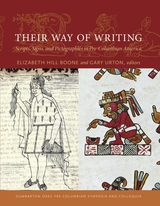 Their Way of Writing: Scripts, Signs, and Pictographies in Pre-Columbian America
Elizabeth Hill Boone
Harvard University Press, 2011 Writing and recording are key cultural activities that allow humans to communicate across time and space. Whereas Old World writing evolved into the alphabetic system that is now employed around the world, the indigenous peoples in the Americas autonomously developed alternative systems that conveyed knowledge in a tangible medium. New World systems range from the hieroglyphic script of the Maya, to the figural and iconic pictographies of the Aztecs, Mixtecs, and Zapotecs in Mexico and the Moche in Peru, to the abstract knotted khipus of the Andes. Like Old World writing, these systems represented a cultural category that was fundamental to the workings of their societies, one that was heavily impregnated with cultural value.
The fifteen contributors to Their Way of Writing: Scripts, Signs, and Pictographies in Pre-Columbian America consider substantive and theoretical issues concerning writing and signing systems in the ancient Americas. They present the latest thinking about these graphic and tactile systems of communication. Their variety of perspectives and their advances in decipherment and understanding constitute a major contribution not only to our understanding of Pre-Columbian and indigenous American cultures but also to our comparative and global understanding of writing and literacy.
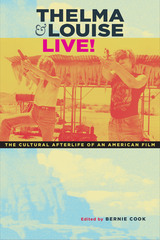 Thelma & Louise Live!: The Cultural Afterlife of an American Film
Edited by Bernie Cook
University of Texas Press, 2007 When they floored their Thunderbird off a cliff rather than surrender to the law, Thelma and Louise became icons of female rebellion, provoking strong reactions from viewers who felt either empowered or outraged by the duo's transgressions of women's traditional roles. The 1991 film quickly became—and continues to be—a potent cultural reference point, even inspiring a bumper sticker that declares, "Thelma & Louise Live!" In this insightful study of Thelma & Louise, six noted film scholars investigate the initial reception and ongoing impact of this landmark film. The writers consider Thelma & Louise from a variety of perspectives, turning attention to the film's promotion and audience response over time; to theories of comedy and the role of laughter in the film; to the film's soundtrack and score; to the performances of stars Susan Sarandon and Geena Davis; to the emergence of Brad Pitt as a star and male sex object; and to the film's place in the history of road and crime film genres. Complementing the scholarly analysis is an in-depth interview of screenwriter Callie Khouri by editor Bernie Cook, as well as reviews of Thelma & Louise that appeared in U.S. News & World Report and Time. Offering myriad new ways of understanding the complex interrelations of gender, identity, and violence, Thelma & Louise Live! attests to the ongoing life and still-evolving meanings of this now-classic film.
 Them and Us: Questions of Citizenship in a Globalizing World
Rob Kroes
University of Illinois Press, 2000 At the dawn of the twenty-first century, all of us consider ourselves to be citizens of something-–but of what? Nation-states? Regions? Ethnic groups? Corporations?
An accomplished set of meditations by one of Europe's leading Americanists, Them and Us is a rich comparative study of European and American cultural traditions and their influence on conceptions of community. In contrast with the ethnic and nationalist allegiances that historically have splintered Europe, Rob Kroes identifies a complex of cultural practices that have mitigated against ethnically rooted divisions in the United States. He argues that the American approach–-articulated by a national rhetoric emphasizing openness rather than closure, diversity rather than uniformity--has much to offer a Europe where the nationalist and ethnic conflicts that spawned two world wars continue to sow terror and destruction.
Kroes discusses European and American attitudes toward the welfare state, the human rights tradition in the United States, and the role of regionalism in shaping conceptions of national identity. He also considers new, transnational forms of cultural membership that are emerging to take the place of nation-based citizenship. He contends that the frame of reference Europeans now use to make sense of their collective situation draws on ingredients provided by the worldwide dissemination of American mass culture. He investigates the way this emerging world culture, under American auspices, affects the way people in their local and national settings structure their sense of the past and conceive of their citizenship.
Imagining a new set of cultural relationships that could serve as the basis for global citizenship, Them and Us is an insightful consideration of the types of solidarity that might weave humankind together into a meaningful community.
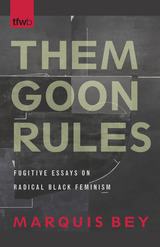 Them Goon Rules: Fugitive Essays on Radical Black Feminism
Marquis Bey
University of Arizona Press, 2019 Marquis Bey’s debut collection, Them Goon Rules, is an un-rulebook, a long-form essayistic sermon that meditates on how Blackness and nonnormative gender impact and remix everything we claim to know.
A series of essays that reads like a critical memoir, this work queries the function and implications of politicized Blackness, Black feminism, and queerness. Bey binds together his personal experiences with social justice work at the New York–based Audre Lorde Project, growing up in Philly, and rigorous explorations of the iconoclasm of theorists of Black studies and Black feminism. Bey’s voice recalibrates itself playfully on a dime, creating a collection that tarries in both academic and nonacademic realms.
Fashioning fugitive Blackness and feminism around a line from Lil’ Wayne’s “A Millie,” Them Goon Rules is a work of “auto-theory” that insists on radical modes of thought and being as a refrain and a hook that is unapologetic, rigorously thoughtful, and uncompromising.
 Thematic Catalogue of the Works of Giovanni Battista Sammartini: Orchestral and Vocal Music
Newell Jenkins and Bathia Churgin
Harvard University Press, 1976 A leading eighteenth-century composer, Sammartini was a key figure in the creation of the classic style, particularly the classic symphony. His symphonies and sonatas have survived in greatest number, but of equal interest is the sacred vocal music, a product of his lifelong service as a church musician. This volume lists all Sammartini's known orchestral and vocal works, sacred and secular—286 items. The entries give an incipit of each movement; instrumentation; date if known; a list of early manuscript and printed copies; and other significant information about variants, circumstances of performance, singers, copyists, and the like. The appendices list arrangements, contrafacta, and lost, doubtful, and spurious works.
Music collections in more than seventy-five libraries have been examined in gathering this material. Most compositions are listed here for the first time. In their introduction the authors provide a detailed biography, and discuss the composer's style, the major manuscript sources, and problems of authenticity. They have also included an extensive bibliography. Their book is basic to any study of Sammartini and of this pivotal period in the history of Western music.
 Thematic Origins of Scientific Thought: Kepler to Einstein, Revised Edition
Gerald Holton
Harvard University Press, 1988 The highly acclaimed first edition of this major work convincingly established Gerald Holton’s analysis of the ways scientific ideas evolve. His concept of “themata,” induced from case studies with special attention to the work of Einstein, has become one of the chief tools for understanding scientific progress. It is now one of the main approaches in the study of the initiation and acceptance of individual scientific insights.
Three principal consequences of this perspective extend beyond the study of the history of science itself. It provides philosophers of science with the kind of raw material on which some of the best work in their field is based. It helps intellectual historians to redefine the place of modern science in contemporary culture by identifying influences on the scientific imagination. And it prompts educators to reexamine the conventional concepts of education in science.
In this new edition, Holton has masterfully reshaped the contents and widened the coverage. Significant new material has been added, including a penetrating account of the advent of quantum physics in the United States, and a broad consideration of the integrity of science, as exemplified in the work of Niels Bohr. In addition, a revised introduction and a new postscript provide an updated perspective on the role of themata. The result of this thoroughgoing revision is an indispensable volume for scholars and students of scientific thought and intellectual history.
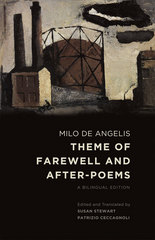 Theme of Farewell and After-Poems: A Bilingual Edition
Milo de Angelis
University of Chicago Press, 2013 Milo De Angelis, born in 1951, is one of the most important living Italian poets. With this volume, Susan Stewart and Patrizio Ceccagnoli bring to English readers for the first time a facing-page edition of his most recent work: his book-length elegy, Theme of Farewell, and the subsequent poems of That Wandering in the Darkness of Courtyards. These two books form a sequence narrating the illness and premature death, in 2003, of the poet’s wife, the writer Giovanna Sicari, a celebrated poet in her own right; they also trace De Angelis’s turn from grief, through time, back to the world. Immediate, perceptive, and woven from the fabric of everyday life in contemporary Milan, the poems never depart from universal human emotions of despair and awakening. Throughout his long career, De Angelis has renewed lyric poetry with the sheer intensity of his forms and insights, and the volumes offered here have won some of the most important Italian literary awards, including the coveted Premio Viareggio.
These inexorable and beautifully crafted translations will be of interest to scholars of contemporary Italian literature, students of contemporary poetry and literary translation, and those who work in comparative literature. Above all, they are bound to speak to any reader in search of a poet writing at the height of his powers of expression.
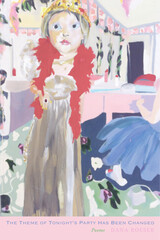 The Theme of Tonight's Party Has Been Changed: Poems
Dana Roeser
University of Massachusetts Press, 2014 Sui generis, Dana Roeser's poems are spoken by a stand-up comic having a bad night at the local club. The long extended syntax, spread over her quirky, syncopated short lines, contains (barely) the speaker's anxieties over an aging father with Parkinson's, the maturation of two daughters, friends at twelve-step meetings and their sometimes suicidal urges—acted on or resisted—and her own place in a world that seems about to spin out of control. Bad weather and tiny economy cars speeding down the interstate next to Jurassic semis become the metaphor, or figurative vehicle, for this poet's sense of her own precariousness.
Roeser brings a host of characters into her poems—a Catholic priest raging against the commercialism of Mother's Day, the injured tennis player James Blake, a man struck by lightning, drunk partygoers, an ex-marine, Sylvia Plath's son Nicholas Hughes, a neighbor, travelers encountered in airport terminals, various talk therapists—and lets them speak. She records with high fidelity the nuances of our ordinary exigencies so that the poems become extraordinary arias sung by a husky-voiced diva with coloratura phrasing to die for, "the dark notes" that Lorca famously called the duende. The book is infused with the energy of misfortune, accident, coincidence, luck, grace, panic, hilarity. The characters and narrator, in extremis, speak their truths urgently.
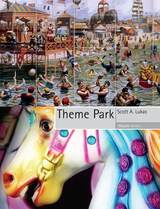 Theme Park
Scott A. Lukas
Reaktion Books, 2008 Theme parks are a uniquely interactive and enduring form of entertainment that have influenced architecture, technology, and culture in surprising ways for more than a century, as Scott Lukas now reveals in his compelling historical chronicle.
Theme Park takes the primitive amusements of pleasure gardens as its starting point and launches from there into a rich, in-depth investigation of the evolution of the theme park over the twentieth century. Lukas examines theme parks in countries around the world—including in the United States, Mexico, Europe, Japan, China, South Africa, and Australia—and how themed fairs and parks developed through diverse means and in a variety of settings. The book examines world-famous and lesser-known parks, including the early parks of Coney Island; Madrid’s Movieworld; a series of World Fairs and their luxurious exhibition halls; Six Flags parks and virtual theme parks today; and, of course, the unparalleled achievements of Disneyland and Disney World.
Lukas analyzes the theme park as a living entity that unexpectedly shapes people, their relationships, and the world around them. Theme parks have now become complex representations of the human mind itself, he contends, through its interpretations of books, feature films, video games, and Web sites. Ultimately, Theme Park reveals, the wider influence of theme parks can be found in the shopping malls, branded stores, and casinos that employ the tricks and techniques of amusement parks to dominate our entertainment world today.
Packed with captivating illustrations, Theme Park takes us on historical roller coaster ride that both reanimates the places that shaped our childhoods and anticipates the future of escapism and fantasy fun.
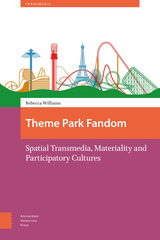 Theme Park Fandom: Spatial Transmedia, Materiality and Participatory Cultures
Rebecca Williams
Amsterdam University Press, 2020 Theme Park Fandom argues that serious study of theme parks and their adult fans has much to tell us about contemporary transmediality and convergence, themed and immersive spaces, and audience relationships with places of meaning. Considering the duopoly of Disney and Universal in Orlando, the book explores a range of theme park experiences including planning trips, meeting characters, eating and drinking, engaging in practices such as cosplay and re-enactment, and memorializing lost attractions. Highlighting key themes such as immersion, materiality, cultural distinctions, and self-identity, the book argues that theme parks are a crucial site for the exploration of transmediality and the development of paratexts. Proposing the key concepts of spatial transmedia and haptic fandom, the book offers analysis of the intersections between fandom, media texts, and merchandise, as well as fans’ own affective and physical responses to visiting the parks.
Theme Park Landscapes: Antecedents and Variations
Terence Young
Harvard University Press The prevalence and influence of “theming” increased so dramatically during the 1990s that theme parks have become a metaphor for postmodern urban life. In particular, critics apply the term “Disneyfication” to any landscape developed to communicate with several audiences, especially when that communication is an attempt to stimulate and direct consumption. While scholars have prepared numerous explorations of this phenomenon, few scholarly studies focus on the landscapes in theme parks. This volume’s authors examine current and past, public and private, obviously and subtly themed landscapes in Asia, Europe, and North America in response to this worldwide development.
Themes and Issues in Asian Cartooning
John A. Lent
University of Wisconsin Press, 1999 Today, comic art is the favorite reading fare for millions of Asians, and is a government-sanctioned, value-added product, as in the case of Korean and Japanese animation. Yet not much is known about Asian cartooning.
Themes and Issues in Asian Cartooning uses overviews and case studies by scholars to discuss Asian animation, humor magazines, gag cartoons, comic strips, and comic books. The first half of the book looks at contents and audiences of Malay humor magazines, cultural labor in Korean animation, the reception of Aladdin in Islamic Southeast Asia, and a Singaporean comic book as a reflection of that society’s personality. Four other chapters treat gender and Asian comics, concentrating on Japanese anime and manga and Indian comic books.
 Themes and Variations: Writings on Music in Honor of Rulan Chao Pian
Bell Yung
Harvard University Press The thirteen essays in this volume underscore the unity and diversity of music research today. Ranging in topic from Gregorian chant to Russian lament, Chinese opera to American spirituals, the essays span the early ninth to the late twentieth centuries and move geographically from East Asia to Europe, North America, and the Pacific. The essays focus on some of the central issues in current musicological and ethnomusicological research: the change and continuity in musical traditions, tune identity and metamorphosis, and the nature and function of musical notation.
Owing to the musical material, the diverse cultural contexts, and the different approaches and methodologies employed, the same theoretical issues are formulated and addressed in various ways. It is through variations that themes grow in significance and beauty. The unity in and coherence of modern musicological discourse, though still elusive, are within reach in this volume.
Themes in Kant's Metaphysics and Ethics
Arthur Melnick
Catholic University of America Press, 2004 Intended for those interested in Kant's contribution to philosophy, this volume provides an overview of Kant's arguments concerning central issues in metaphysics and ethics.
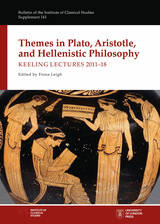 Themes in Plato, Aristotle, and Hellenistic Philosophy: Keeling Lectures 2011-18
Edited by Fiona Leigh
University of London Press, 2020 The present volume collects together papers based on the annual Keeling Memorial Lecture in ancient philosophy given at University College London, over 2011-18 (and one from 2004, previously unpublished). It contains contributions to theoretical as well as practical ancient philosophy, and in some cases, to both. Susanne Bobzien argues that Frege plagiarised the Stoics in respect of logic, Gail Fine compares uses of doxa and epistêmê in the Phaedo to contemporary notions of belief and knowledge, David Sedley offers a novel interpretation of ‘safe’ causal explanation in the Phaedo, and Gábor Betegh understands the ingredients of the soul in the Timaeus as structuring thought and speech. Dorothea Frede presents new considerations against a ‘particularist’ reading of Aristotle’s ethics, Lesley Brown examines the role of agreement in establishing what is just and the correctness of names in Plato, and Gisela Striker gives an analysis of the role of Stoic therapy in the good life. A. A. Long details a new reading of divinity in the Republic that reveals the Good as the essence of the divine, and Malcolm Schofield explores the tension between unfettered theoretical debate and the demand of determinacy in practical philosophy in Cicero.
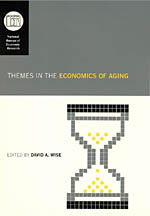 Themes in the Economics of Aging
Edited by David A. Wise
University of Chicago Press, 2001 In the past few years, the economic ramifications of aging have garnered close attention from a group of NBER researchers led by David A. Wise. In this volume, Wise and his collaborators continue to analyze a nexus of age-related issues.
This volume begins by looking at the implications of private and public personal retirement plans, focusing in particular on the impact of 401(k) programs on retirement strategies in light of potential social security reform and factors such as annuitization and on asset accumulation. Next, the often-observed relationship between health and wealth is dissected from two different perspectives and correlated with striking increases in health-care spending over the past two decades, despite the improved health of older populations. The volume concludes with an investigation of the retirement effects of various social security provisions in both U.S. and German systems.
This carefully developed collection expands the current investigative focus and broadens the dialogue on a rapidly growing area of social and economic concern.
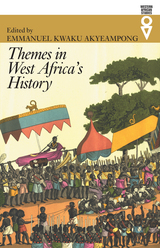 Themes in West Africa’s History
Emmanuel Kwaku Akyeampong
Ohio University Press, 2006 There has long been a need for a new textbook on West Africa’s history. In Themes in West Africa’s History, editor Emmanuel Kwaku Akyeampong and his contributors meet this need, examining key themes in West Africa’s prehistory to the present through the lenses of their different disciplines. The contents of the book comprise an introduction and thirteen chapters divided into three parts. Each chapter provides an overview of existing literature on major topics, as well as a short list of recommended reading, and breaks new ground through the incorporation of original research. The first part of the book examines paths to a West African past, including perspectives from archaeology, ecology and culture, linguistics, and oral traditions. Part two probes environment, society, and agency and historical change through essays on the slave trade, social inequality, religious interaction, poverty, disease, and urbanization. Part three sheds light on contemporary West Africa in exploring how economic and political developments have shaped religious expression and identity in significant ways. Themes in West Africa’s History represents a range of intellectual views and interpretations from leading scholars on West Africa’s history. It will appeal to college undergraduates, graduate students, and scholars in the way it draws on different disciplines and expertise to bring together key themes in West Africa’s history, from prehistory to the present.
Themes of Indigenous Acculturation in Northwest Mexico
Edited by Thomas B. Hinton and Phil C. Weigand
University of Arizona Press, 1981 The Anthropological Papers of the University of Arizona is a peer-reviewed monograph series sponsored by the School of Anthropology. Established in 1959, the series publishes archaeological and ethnographic papers that use contemporary method and theory to investigate problems of anthropological importance in the southwestern United States, Mexico, and related areas.
 Themes of Work and Love in Adulthood
Neil J. Smelser
Harvard University Press, 1980 To love and to work, Freud's famous definition of psychological maturity, here becomes the focussing principle for a renewed examination of the dominant themes that play themselves out in adult life. Erik Erikson, Neil Smelser, and nine leading experts in adult development consider the stages that adults pass through and the crises that adults confront as they attempt to create a meaningful life.
Themes of Work and Love in Adulthood is a book that raises many fascinating questions about adult experience. How, for example, does work affect personality? Are love and work in competition; must one be pursued at the expense of the other? Is there a point in life past which men lay less stress on mastery and turn more toward emotional fulfillment? And do women experience a shift in the opposite direction? More generally, why do adult crises fall into predictable patterns and how do adults grow as they respond to these crises? Is the recent broadening of standards for adult conduct an opportunity for personal liberation or a source of personal debilitation?
Much more than a summary of current work on adulthood, Themes of Work and Love in Adulthood is a book full of unusual rewards: Erik Erikson's sensitive reconstruction of the entanglements of love and work revealed in the correspondence between Freud and Jung; Ann Swidler's fascinating discussion of the historical transformation of the love ideal from medieval times to its contemporary form; Robert LeVine's analysis of the adult life course in an African culture. When these unique essays are added to the important position papers by major theorists of adult development—Daniel Levinson, Roger Gould, and Marjorie Fiske—the result is a book that is both useful and exciting.
Themes out of School: Effects and Causes
Stanley Cavell
University of Chicago Press, 1988 In the first essay of this book, Stanley Cavell characterizes philosophy as a "willingness to think not about something other than what ordinary human beings think about, but rather to learn to think undistractedly about things that ordinary human beings cannot help thinking about, or anyway cannot help having occur to them, sometimes in fantasy, sometimes as a flash across a landscape."
Fantasies of film and television and literature, flashes across the landscape of literary theory, philosophical discourse, and French historiography give Cavell his starting points in these twelve essays. Here is philosophy in and out of "school," understood as a discipline in itself or thought through the works of Shakespeare, Molière, Kierkegaard, Thoreau, Brecht, Makavejev, Bergman, Hitchcock, Astaire, and Keaton.
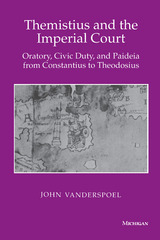 Themistius and the Imperial Court: Oratory, Civic Duty, and Paideia from Constantius to Theodosius
John Vanderspoel
University of Michigan Press, 1995 For generations the debate has continued: can politicians, or mid-level administrators, speak freely and say what they think, or must they describe their superiors in purely flattering ways and abandon any philosophy of independent thought? The politician and philosopher Themistius faced these same issues in the later fourth century, in composing and delivering his panegyrics for several Roman emperors.
John Vanderspoel examines the relationship between Themistius and the emperors whom he served, and assesses realistically how philosopher and emperor interacted. Themistius' speeches cover a range of periods and topics, and offer an important body of evidence for governmental affairs in the later fourth century.
Themistius and the Imperial Court includes chapters on Themistius himself, as well as on his relations with the emperors Constantius, Julian, Jovian, Valens, and Theodosius. Appendices discuss Themistius' philosophical works and extant speeches, present translations of selected sections of his Orations, and offer a chronology of Themistius' speeches, among other topics.
Themistius and the Imperial Court will be of interest to ancient historians, classicists, students and scholars of the ancient Near East, and all those interested in power politics within governing classes.
John Vanderspoel is Associate Professor of Ancient History, University of Calgary. He has written numerous articles and reviews on late antiquity.
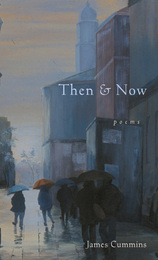 Then and Now: Poems
James Cummins
Ohio University Press, 2004 James Cummins’s first book of poems, The Whole Truth, became known throughout much of the poetry world as the “Perry Mason sestinas.” His second book, Portrait in a Spoon, was chosen by Richard Howard for the James Dickey Prize Contemporary Poetry Series. His latest and most accomplished work is collected in Then and Now, which reflects the same inventiveness and wit evident in his earlier books, with a deepening of tone and spirit. The result is a collection of poems filled with feeling and with Cummins’s signature anguished humor. If the language of poetry is a way into a hall of mirrors of the self, it can be a way out, too. The voice that emerges in Then and Now is sane, imaginative, bemused, and sly, not only taking responsibility for the character of the writer put fully on display, but ironically and affectionately exploring how this process occurs. Doing Lunch You have lunch with a friend.
You put on a false face for him,
because he is your friend.
You want to spare him your
maunderings,
your lies and malfeasance. But this is just what your friend desires,
because he is your friend.
He wants your face to fall open
in front of him and twitch
like a rabbit hit on the fly. He says he wants the latest word
from the border region between
narcissism and an inner life.
And laughs.
Shamelessly, you tell him everything,
because he is your friend.
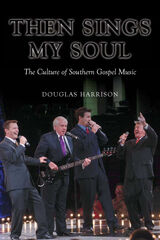 Then Sings My Soul: The Culture of Southern Gospel Music
Douglas Harrison
University of Illinois Press, 2012 In this ambitious book on southern gospel music, Douglas Harrison reexamines the music's historical emergence and its function as a modern cultural phenomenon. Rather than a single rhetoric focusing on the afterlife as compensation for worldly sacrifice, Harrison presents southern gospel as a network of interconnected messages that evangelical Christians use to make individual sense of both Protestant theological doctrines and their own lived experiences. Harrison explores how listeners and consumers of southern gospel integrate its lyrics and music into their own religious experience, building up individual--and potentially subversive--meanings beneath a surface of evangelical consensus. Reassessing the contributions of such figures as Aldine Kieffer, James D. Vaughan, and Bill and Gloria Gaither, Then Sings My Soul traces an alternative history of southern gospel in the twentieth century, one that emphasizes the music's interaction with broader shifts in American life beyond the narrow confines of southern gospel's borders. His discussion includes the "gay-gospel paradox"--the experience of non-heterosexuals in gospel music--as a cipher for fundamentalism's conflict with the postmodern world.
Then, Something
Patricia Fargnoli
Tupelo Press, 2009 A radiant, bravely reflective new book by a poet loved for poems that sing like psalms as they confront the challenges of persisting through time. Following her award-winning volume Duties of the Spirit (also available from Tupelo Press), the recently retired Poet Laureate of New Hampshire reaches further and delves deeper than ever in Then, Something.
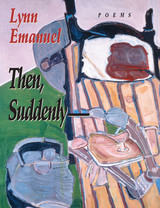 Then Suddenly--
Lynn Emanuel
University of Pittsburgh Press, 1999 Finalist for ForeWord Magazine’s 1999 Poetry Book of the Year
A reader and a writer don their respective roles and embark on the journey of a book. This is their story--ultimately a love story--darkly funny, mournful, testy. It is about a reader who at times presides over the page like a god, and at others follows the leash of the author's voice through the dark streets of the book like a dog, and it is about a writer of determined slipperiness. As we read, we think that each of us is The Reader, the one who knows the Real Story. But the more we think we understand, the more the story moves away from us—all is not what it seems.
This eagerly awaited third volume by the poet whose work The New York Times described as "at once charmed and frightening" is a book of high-spirited subversiveness, a work of argument, seduction, and a relentless devotion to language. Then, Suddenly— bristles with the sound of the author's voice--insistent, vital, hilarious, and iconoclastic--tearing away at the confinement of the page and at the distance between the page and the reader. Emanuel's images are dazzling. She creates a performance that is fearsome and funny in its portrayal of the argument between the work of the text and the world of the body. The Gettsyburg Review has called her a writer of "exquisite craftsmanship" who can "strike from language . . . images chiseled clean as bas-relief." Then, Suddenly— is a book of spectacle and verve, part elegy, part vaudeville.
then telling be the antidote
Xiao Yue Shan
Tupelo Press, 2024 In poems of memory, psychogeography, desire, and self-mythologization, then telling be the antidote is Xiao Yue Shan’s assertion against the malignancy of forceful silences.
By illuminating what has been left untold, these writings present the vivid landscape of a mind layering itself over the world, thinking and speaking its way through a myriad of places, objects, and visions. From rooms overlooking Tokyo rivers to Shanghai streets in the thrall of nighttime, Shan throws light on a nation’s quieted crevices, on the distances between the carnal and the eternal, and most pivotally, on the ability of language to elucidate fact with imagination.
 Then They Started Shooting: Growing Up in Wartime Bosnia
Lynne Jones
Harvard University Press, 2004 You are nine years old. Your best friend's father is arrested, half your classmates disappear from school, and someone burns down the house across the road. You think your neighbors were planning to kill your family. You are eight years old and imprisoned in your home by your father's old friends. You are ten years old and must climb a mountain at night to escape the soldiers trying to shoot you.
What happens to children who grow up with war? How do they live with the daily reality of danger, hunger, and loss--and how does it shape the adults they become?
In Then They Started Shooting, child psychiatrist Lynne Jones draws the reader into the compelling stories of Serbian and Muslim children who came of age during the Bosnian wars of the 1990s. These children endured hardship, loss, family disruption, and constant uncertainty, and yet in a blow to psychiatric orthodoxy, few showed lasting signs of trauma. Thoughts of their personal futures filled their minds, not memories of war.
And yet, Jones suggests in a chilling conclusion, the war affected them deeply. Officially citizens of the same country, the two communities live separate, wary lives. The Muslims hope for reconciliation but cannot believe in it while so many cannot go home and war criminals are still at large. The Serbs resent the outside world, NATO, and fear the return of their Muslim neighbors. Cynical about politics, all of them mistrust their elected leaders. War may end, but the persistence of corruption and injustice keep wounds from healing.
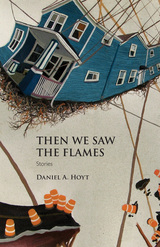 Then We Saw the Flames: Stories
Daniel A. Hoyt
University of Massachusetts Press, 2009 In this freewheeling debut collection, Daniel A. Hoyt takes us from the swamps of Florida to the streets of Dresden, to the skies above America, to the tourist hotels of Acapulco, to the southwest corner of Nebraska. Along the way, we encounter a remarkable group of characters all struggling to find their footing in an unsettling world.
Sometimes magical, sometimes realistic, sometimes absurd, these stories reveal people teetering on the dangerous edge of their lives. In "Amar," a Turkish restaurant owner deals with skinheads and the specter of violence that haunts his family. In "Boy, Sea, Boy," a shipwrecked sailor receives a surreal visitor, a version of himself as a child. In "The Collection," a father and son squander a trove of bizarre and fanciful objects. And in "The Kids," a suburban couple grasp for meaning after discovering children eating from their trash.
In each of these stories, characters find themselves challenged by the political, cultural, and spiritual forces that define their lives. With a clear eye and a steady hand, Hoyt explores a fragile balance: the flames—fueled by love, loss, hope, and family—shed new light on us. Sometimes we feel warmth, and sometimes we simply burn.
Theo: An Autobiography
Theodore Bikel
University of Wisconsin Press, 2002 An award-winning actor on screen and stage (The Defiant Ones, The African Queen, The Sound of Music, My Fair Lady, Fiddler on the Roof), an activist for civil rights and progressive causes worldwide, and a singer whose voice has won him great applause, Theodore Bikel here tells his own compelling life story. Born in Austria, raised in Palestine, educated in England, and with a stellar career in the United States and around the world, Bikel offers a personal history parallel to momentous events of the twentieth century. In an eloquent, fiercely committed voice, he writes of the Third Reich, the birth of the State of Israel, the McCarthy witch hunts of the 1950s, and the tumultuous 1960s in America. In a new postscript to this paperback edition, he looks at recent events in the Middle East and takes both sides to task for their excesses.
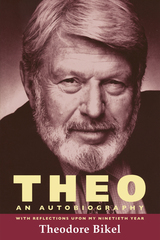 Theo: An Autobiography
Theodore Bikel
University of Wisconsin Press, 2014 An award-winning actor on screen and stage (The Defiant Ones, The African Queen, The Sound of Music, My Fair Lady, Fiddler on the Roof), an activist for civil rights and progressive causes worldwide, and a singer whose voice has won him great applause, Theodore Bikel here tells his own compelling life story. Born in Austria, raised in Palestine, educated in England, and with a stellar career in the United States and around the world, Bikel offers a personal history parallel to momentous events of the twentieth century. In an eloquent, fiercely committed voice, he writes of the Third Reich, the birth of the State of Israel, the McCarthy witch hunts of the 1950s, the tumultuous 1960s in America, and events in the Middle East.
In this edition celebrating Bikel’s ninetieth birthday, he looks back in a new chapter at his youth in prewar Vienna, his adolescent years, his continued joy in performing timeless songs, his return to Vienna in recent years, and the active life that keeps him feeling young even after nearly a century of adventure.
 Theocritus. Moschus. Bion
Theocritus, Moschus, and Bion; edited and translated by Neil Hopkinson
Harvard University Press, 2015 The father of pastoral poetry and his Hellenistic heirs.
Theocritus (early third century BC), born in Syracuse and also active on Cos and at Alexandria, was the inventor of the bucolic genre. Like his contemporary Callimachus, Theocritus was a learned poet who followed the aesthetic, developed a generation earlier by Philitas of Cos (LCL 508), of refashioning traditional literary forms in original ways through tightly organized and highly polished work on a small scale (thus the traditional generic title Idylls: “little forms”). Although Theocritus composed in a variety of genres or generic combinations, including encomium, epigram, hymn, mime, and epyllion, he is best known for the poems set in the countryside, mostly dialogues or song-contests, that combine lyric tone with epic meter and the Doric dialect of his native Sicily to create an idealized and evocatively described pastoral landscape, whose lovelorn inhabitants, presided over by the Nymphs, Pan, and Priapus, use song as a natural mode of expression.
The bucolic/pastoral genre was developed by the second and third members of the Greek bucolic canon, Moschus (fl. mid second century BC, also from Syracuse) and Bion (fl. some fifty years later, from Phlossa near Smyrna), and remained vital through Greco-Roman antiquity and into the modern era.
This edition of Theocritus, Moschus, and Bion, together with the so-called “pattern poems” included in the bucolic tradition, replaces the earlier Loeb Classical Library edition by J. M. Edmonds (1912), using the critical texts of Gow (1952) and Gallavotti (1993) as a base and providing a fresh translation with ample annotation.
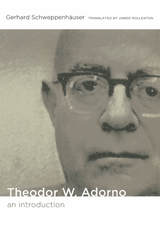 Theodor W. Adorno: An Introduction
Gerhard Schweppenhäuser
Duke University Press, 2009 Theodor W. Adorno (1903–1969) was one of the twentieth century’s most important thinkers. In light of two pivotal developments—the rise of fascism, which culminated in the Holocaust, and the standardization of popular culture as a commodity indispensable to contemporary capitalism—Adorno sought to evaluate and synthesize the essential insights of Western philosophy by revisiting the ethical and sociological arguments of his predecessors: Kant, Nietzsche, Hegel, and Marx. This book, first published in Germany in 1996, provides a succinct introduction to Adorno’s challenging and far-reaching thought. Gerhard Schweppenhäuser, a leading authority on the Frankfurt School of critical theory, explains Adorno’s epistemology, social and political philosophy, aesthetics, and theory of culture. After providing a brief overview of Adorno’s life, Schweppenhäuser turns to the theorist’s core philosophical concepts, including post-Kantian critique, determinate negation, and the primacy of the object, as well as his view of the Enlightenment as a code for world domination, his diagnosis of modern mass culture as a program of social control, and his understanding of modernist aesthetics as a challenge to conceive an alternative politics. Along the way, Schweppenhäuser illuminates the works widely considered Adorno’s most important achievements: Minima Moralia, Dialectic of Enlightenment (co-authored with Horkheimer), and Negative Dialectics. Adorno wrote much of the first two of these during his years in California (1938–49), where he lived near Arnold Schoenberg and Thomas Mann, whom he assisted with the musical aesthetics at the center of Mann’s novel Doctor Faustus.
 Theodor W. Adorno: One Last Genius
Detlev Claussen
Harvard University Press, 2008 He was famously hostile to biography as a literary form. And yet this life of Adorno by one of his last students is far more than literary in its accomplishments, giving us our first clear look at how the man and his moment met to create “critical theory.” An intimate picture of the quintessential twentieth-century transatlantic intellectual, the book is also a window on the cultural ferment of Adorno’s day—and its ongoing importance in our own.
The biography begins at the shining moment of the German bourgeoisie, in a world dominated by liberals willing to extend citizenship to refugees fleeing pogroms in Eastern Europe. Detlev Claussen follows Theodor Wiesengrund Adorno (1903–1969) from his privileged life as a beloved prodigy to his intellectual coming of age in Weimar Germany and Vienna; from his exile during the Nazi years, first to England, then to the United States, to his emergence as the Adorno we know now in the perhaps not-so-unlikely setting of Los Angeles. There in 1943 with his collaborator Max Horkheimer, Adorno developed critical theory, whose key insight—that to be entertained is to give one’s consent—helped define the intellectual landscape of the twentieth century.
In capturing the man in his complex relationships with some of the century’s finest minds—including, among others, Arnold Schoenberg, Walter Benjamin, Thomas Mann, Siegfried Kracauer, Georg Lukács, Hannah Arendt, and Bertolt Brecht—Claussen reveals how much we have yet to learn from Theodor Adorno, and how much his life can tell us about ourselves and our time.
 Theodore H. White and Journalism As Illusion
Joyce Hoffmann
University of Missouri Press, 1995 In this groundbreaking study, Joyce Hoffmann examines a critical twenty-five-year period in the work of one of the most influential journalists of the twentieth century. Theodore H. White was already a celebrated reporter when Jacqueline Kennedy summoned him for an exclusive interview in the aftermath of her husband's assassination. With her help, White would preserve what the First Lady claimed had been John F. Kennedy's vision of the New Frontier as an incarnation of that wistful, romantic kingdom--Camelot. Over the years, friends and advisers to Kennedy declared that they had never heard the president speak of Camelot. But White's article, which ran in Life magazine, created a myth that still endures in the popular consciousness. That story was just one of many by Theodore White that had a lasting impact on the nation. As a correspondent for several of the country's most popular magazines, he covered the crucial events of the 1940s, '50s, and '60s. His best-selling book The Making of the President 1960 changed political reporting forever. A gifted and likable man with a remarkable skill for ingratiating himself with others, White earned the confidence of key political, military, and diplomatic leaders. First in the Far East, later in Europe, and finally in Washington, D.C., he became a confidant and adviser rather than an adversary to the figures he covered for the news, following a pattern set by elite journalists. Even as he played the impartial reporter, White kept secrets in order to maintain access to his important sources, and he occasionally allowed his subjects, including John F. Kennedy and Nelson Rockefeller, to make changes in his work before publication. Clinging to the illusion of objectivity, White--like other leading journalists in the postwar years--wrote about the world not as it was but as he believed it ought to be. Hoffmann relates the little-known episode in White's career when he intentionally obscured the truth about Chiang Kai-shek's corrupt and inept Nationalist government because he believed that undermining China's cause would be "a disservice to democracy." No other book so thoroughly documents how a first-rank journalist can become a political insider and distort the news without losing the gloss of impartiality that is supposed to accompany the profession. Impressively researched, skillfully written, Theodore H. White and Journalism as Illusion is an unflinching look at a key figure in the history of American journalism and at the profession itself.
Theodore Roosevelt: A Literary Life
Thomas Bailey and Katherine Joslin
University Press of New England, 2018 Of all the many biographies of Theodore Roosevelt, none has presented the twenty-sixth president as he saw himself: as a man of letters. This fascinating account traces Roosevelt’s lifelong engagement with books and discusses his writings from childhood journals to his final editorial, finished just hours before his death. His most famous book, The Rough Riders—part memoir, part war adventure—barely begins to suggest the dynamism of his literary output. Roosevelt read widely and deeply, and worked tirelessly on his writing. Along with speeches, essays, reviews, and letters, he wrote history, autobiography, and tales of exploration and discovery. In this thoroughly original biography, Roosevelt is revealed at his most vulnerable—and his most human.
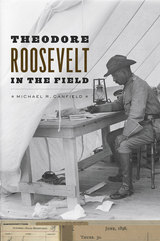 Theodore Roosevelt in the Field
Michael R. Canfield
University of Chicago Press, 2015 Never has there been a president less content to sit still behind a desk than Theodore Roosevelt. When we picture him, he's on horseback or standing at a cliff’s edge or dressed for safari. And Roosevelt was more than just an adventurer—he was also a naturalist and campaigner for conservation. His love of the outdoor world began at an early age and was driven by a need not to simply observe nature but to be actively involved in the outdoors—to be in the field. As Michael R. Canfield reveals in Theodore Roosevelt in the Field, throughout his life Roosevelt consistently took to the field as a naturalist, hunter, writer, soldier, and conservationist, and it is in the field where his passion for science and nature, his belief in the manly, “strenuous life,” and his drive for empire all came together.
Drawing extensively on Roosevelt’s field notebooks, diaries, and letters, Canfield takes readers into the field on adventures alongside him. From Roosevelt’s early childhood observations of ants to his notes on ornithology as a teenager, Canfield shows how Roosevelt’s quest for knowledge coincided with his interest in the outdoors. We later travel to the Badlands, after the deaths of Roosevelt’s wife and mother, to understand his embrace of the rugged freedom of the ranch lifestyle and the Western wilderness. Finally, Canfield takes us to Africa and South America as we consider Roosevelt’s travels and writings after his presidency. Throughout, we see how the seemingly contradictory aspects of Roosevelt’s biography as a hunter and a naturalist are actually complementary traits of a man eager to directly understand and experience the environment around him.
As our connection to the natural world seems to be more tenuous, Theodore Roosevelt in the Field offers the chance to reinvigorate our enjoyment of nature alongside one of history’s most bold and restlessly curious figures.
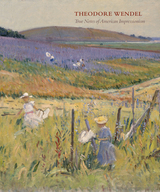 Theodore Wendel: True Notes of American Impressionism
Laurene Buckley
The Artist Book Foundation, 2019 One of the first American artists to bring French Impressionism home to develop on native soil, Theodore Wendel is likely the last to have a monograph that records his remarkable career and stunning oeuvre. His portraits and still lifes, and especially his landscapes, not only exemplify the joyous palette and vigorous brushwork of the genre, but they also mirror the idyllic, transient beauty of rural hamlets along the Massachusetts coast—Gloucester and Ipswich, the dual epicenters of his distinguished career.
One of the original “Duveneck boys” who studied in Munich at the Royal Academy, Wendel followed his mentor to Florence and Venice; he later went on to Paris and ultimately joined a colony of young artists at Giverny. The scenes and subject matter in the works he completed there are among the earliest by an American artist to adopt and evolve Impressionist strategies. Upon his return to America, he spent the next decades rendering scenes of the farmland and coast north of Boston that contemporary critics acclaimed as some of the best they had seen. Yet despite his talent and the significant accolades earned during his career, in the near-century following his death the recognition of his achievements has faded. The Artist Book Foundation is delighted to have the opportunity to remedy this situation with its forthcoming monograph on the artist, Theodore Wendel: True Notes of American Impressionism.
Laurene Buckley’s years of exhaustive research inform an engaging and detailed narrative of Wendel’s time in Europe and his many years capturing the essence of the farms and fishing villages along the rural coast of Massachusetts. Thanks to her efforts, the book will feature many of his best works, a number of which are in private collections. An informative introduction by William H. Gerdts provides significant artistic context for Wendel and explains the artist’s deft ability to draw the viewer into a scene. Concluding the monograph, an extensive chronology, exhibition history, and bibliography complete the scholarship on this long overdue tribute to a master of American Impressionism.
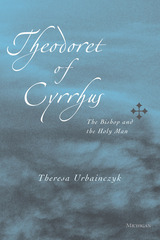 Theodoret of Cyrrhus: The Bishop and the Holy Man
Theresa Urbainczyk
University of Michigan Press, 2002 The writing of a saint's life can be as political as it is pious. In this, her second book, Theresa Urbainczyk demonstrates how one collection of saints' lives--the Religious History of Theodoret, bishop of Cyrrhus--both prescribes and describes the relationship between ascetics and the early Church.
With the conversion of Constantine and his subsequent championing of the Christian cause, the Church rapidly began to increase its wealth and status. As coins filled the coffers of God, some Christians came to feel that their religion had become corrupted. They fled to the desert wastes, seeking a purer, holier life. These recluses and ascetics are the subjects of Theodoret's Religious History. The Syrian bishop had known many of them, some for all his life.
Urbainczyk argues that Theodoret's work was not merely written as an act of piety, but was in fact a very political treatise, addressing the theological disputes of his day. The main tensions of the early fifth century lay between the sees of Syrian Antioch and Egyptian Alexandria. One of Theodoret's aims was to show that Syria had produced individuals as pious as those of Egypt, about whom much had already been written. Urbainczyk studies the social background of these Syrian ascetics, describes the relationship between Theodoret's heroes and the Church community, and investigates how Theodoret presents his own personal relationship with the holy men.
This book is the first to examine Theodoret's role in his own work. Urbainczyk argues that the intimate details of Theodoret's life were not let slip accidentally but were inserted deliberately to buttress his own threatened position and to show how these independent men of God deferred to no one but himself.
Theodoret of Cyrrhus is an invaluable study for students of late antiquity, scholars of early Church history, early medieval historiographers and hagiographers.
Theresa Urbainczyk is College Lecturer in Classics, University College, Dublin.
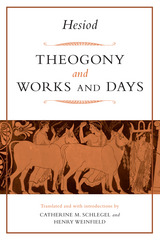 Theogony and Works and Days
Hesiod
University of Michigan Press, 2006 Written in the late eighth century BC by Hesiod, one of the oldest known of Greek poets, Theogony and Works and Days represent the earliest account of the origin of the Greek gods, and an invaluable compendium of advice for leading a moral life, both offering unique insights into archaic Greek society. There are a number of modern translations of Hesiod available, rendered in serviceable English, but until now no one has created a work of literature equal to the original. This translation is the result of a unique collaboration between a classicist and a poet, capturing in English fourteeners the works’ true poetic flavor while remaining faithful to the Greek text and the archaic world in which it was composed.
This translation contains a general introduction, a translator’s introduction, notes, and a glossary. It will be of interest to general readers, students of and specialists in classical literature, and lovers of poetry.
"This Schlegel-Weinfield translation of Hesiod is superbly crafted: compelling, unforgettable poetry to be read aloud with delight and gratitude."
—Allen Mandelbaum, Endowed Kenan Professor of Humanities, Wake Forest University
"This exciting and unique collaboration between a classical philologist and a poet will not just provide insight into archaic Greek society, but also offer something new: the opportunity to experience the richness of Hesiod's style, language, and modes of thought with remarkable fidelity to the ancient Greek. Weinfield and Schlegel make Hesiod sing."
—Carole Newlands, Classics Department, University of Wisconsin
"Schlegel and Weinfield have produced one of the most remarkable of a current resurgence of translations from the classics, allowing the modern world to hear a poet who may have known Homer. Hesiod’s song makes us understand why the Greeks thought a poet could draw dolphins through the seas or raise the walls of Thebes. Weinfield translates by ear and transfers what he hears to the page, resonant fourteeners, a worthy echo of the past." —Charles Stanley Ross, Professor, Department of English, and Director, Comparative Literature, PurdueUniversity
Catherine Schlegel is Associate Professor of Classics, University of Notre Dame. Henry Weinfield is Professor and Chair of Liberal Studies, University of Notre Dame, and translator of The Collected Poems of Stephane Mallarme.
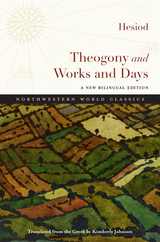 Theogony and Works and Days: A New Bilingual Edition
Hesiod, Translated from the Greek by Kimberly Johnson
Northwestern University Press, 2017 Widely considered the first poet in the Western tradition to address the matter of his own experience, Hesiod occupies a seminal position in literary history. His Theogony brings together and formalizes many of the narratives of Greek myth, detailing the genealogy of its gods and their violent struggles for power. The Works and Days seems on its face to be a compendium of advice about managing a farm, but it ranges far beyond this scope to meditate on morality, justice, the virtues of a good life, and the place of humans in the universe. These poems are concerned with orderliness and organization, and they proclaim those ideals from small-scale to vast, from a handful of seeds to the story of the cosmos. Presented here in a bilingual edition, Johnson’s translation takes care to preserve the structure of Hesiod’s lines and sentences, achieving a sonic and rhythmic balance that enables us to hear his music across the millennia.
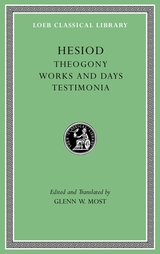 Theogony. Works and Days. Testimonia
Hesiod
Harvard University Press, 2018 Antiquity’s original didactic poet.
Hesiod describes himself as a Boeotian shepherd who heard the Muses call upon him to sing about the gods. His exact dates are unknown, but he has often been considered a younger contemporary of Homer.
The first volume of this revised Loeb Classical Library edition offers Hesiod’s two extant poems and a generous selection of testimonia regarding his life, works, and reception. In Theogony, Hesiod charts the history of the divine world, narrating the origin of the universe and the rise of the gods, from first beginnings to the triumph of Zeus, and reporting on the progeny of Zeus and of goddesses in union with mortal men. In Works and Days, Hesiod shifts his attention to humanity, delivering moral precepts and practical advice regarding agriculture, navigation, and many other matters; along the way he gives us the myths of Pandora and of the Golden, Silver, and other Races of Men.
The second volume contains The Shield and extant fragments of other poems, including the Catalogue of Women, that were attributed to Hesiod in antiquity. The former provides a Hesiodic counterpoint to the shield of Achilles in the Iliad; the latter presents several legendary episodes organized according to the genealogy of their heroes’ mortal mothers. None of these is now thought to be by Hesiod himself, but all have considerable literary and historical interest.
Glenn W. Most has thoroughly revised his edition to take account of the textual and interpretive scholarship that has appeared since its initial publication.
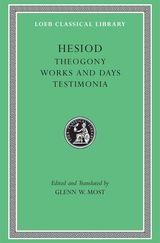 Theogony. Works and Days. Testimonia
Hesiod
Harvard University Press, 2006 Hesiod describes himself as a Boeotian shepherd who heard the Muses call upon him to sing about the gods. His exact dates are unknown, but he has often been considered a younger contemporary of Homer. This volume of the new Loeb Classical Library edition offers a general introduction, a fluid translation facing an improved Greek text of Hesiod's two extant poems, and a generous selection of testimonia from a wide variety of ancient sources regarding Hesiod's life, works, and reception.
In Theogony Hesiod charts the history of the divine world, narrating the origin of the universe and the rise of the gods, from first beginnings to the triumph of Zeus, and reporting on the progeny of Zeus and of goddesses in union with mortal men. In Works and Days Hesiod shifts his attention to the world of men, delivering moral precepts and practical advice regarding agriculture, navigation, and many other matters; along the way he gives us the myths of Pandora and of the Golden, Silver, and other Races of Men.
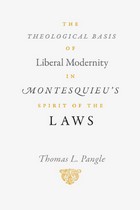 The Theological Basis of Liberal Modernity in Montesquieu's "Spirit of the Laws"
Thomas L. Pangle
University of Chicago Press, 2010 The Spirit of the Laws—Montesquieu’s huge, complex, and enormously influential work—is considered one of the central texts of the Enlightenment, laying the foundation for the liberally democratic political regimes that were to embody its values. In his penetrating analysis, Thomas L. Pangle brilliantly argues that the inherently theological project of Enlightenment liberalism is made more clearly—and more consequentially— in Spirit than in any other work. In a probing and careful reading, Pangle shows how Montesquieu believed that rationalism, through the influence of liberal institutions and the spread of commercial culture, would secularize human affairs. At the same time, Pangle uncovers Montesquieu’s views about the origins of humanity’s religious impulse and his confidence that political and economic security would make people less likely to sacrifice worldly well-being for otherworldly hopes. With the interest in the theological aspects of political theory and practice showing no signs of diminishing, this book is a timely and insightful contribution to one of the key achievements of Enlightenment thought.
 Theological Bioethics: Participation, Justice, and Change
Lisa Sowle Cahill
Georgetown University Press, 2005 The field of bioethics was deeply influenced by religious thinkers as it emerged in the 1960s and early 1970s. Since that time, however, a seemingly neutral political liberalism has pervaded the public sphere, resulting in a deep suspicion of those bringing religious values to bear on questions of bioethics and public policy. As a theological ethicist and progressive Catholic, Lisa Sowle Cahill does not want to cede the "religious perspective" to fundamentalists and the pro-life movement, nor does she want to submit to the gospel of a political liberalism that champions individual autonomy as holy writ. In Theological Bioethics, Cahill calls for progressive religious thinkers and believers to join in the effort to reclaim the best of their traditions through jointly engaging political forces at both community and national levels. In Cahill's eyes, just access to health care must be the number one priority for this type of "participatory bioethics." She describes a new understanding of theological bioethics that must go beyond decrying injustice, beyond opposing social practices that commercialize human beings, beyond painting a vision of a more egalitarian future. Such a participatory bioethics, she argues, must also take account of and take part in a global social network of mobilization for change; it must seek out those in solidarity, those involved in a common calling to create a more just social, political, and economic system. During the past two decades Cahill has made profound contributions to theological ethics and bioethics. This is a magisterial and programmatic statement that will alter how the religiously inclined understand their role in the great bioethics debates of today and tomorrow that yearn for clear thinking and prophetic wisdom.
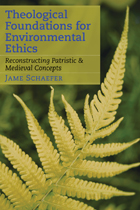 Theological Foundations for Environmental Ethics: Reconstructing Patristic and Medieval Concepts
Jame Schaefer
Georgetown University Press, 2009 Earth is imperiled. Human activities are adversely affecting the land, water, air, and myriad forms of biological life that comprise the ecosystems of our planet. Indicators of global warming and holes in the ozone layer inhibit functions vital to the biosphere. Environmental damage to the planet becomes damaging to human health and well-being now and into the future—and too often that damage affects those who are least able to protect themselves. Can religion make a positive contribution to preventing further destruction of biological diversity and ecosystems and threats to our earth? Jame Schaefer thinks that it can, and she examines the thought of Christian Church fathers and medieval theologians to reveal and retrieve insights that may speak to our current plight. By reconstructing the teachings of Augustine, Thomas Aquinas, and other classic thinkers to reflect our current scientific understanding of the world, Schaefer shows how to "green" the Catholic faith: to value the goodness of creation, to appreciate the beauty of creation, to respect creation's praise for God, to acknowledge the kinship of all creatures, to use creation with gratitude and restraint, and to live virtuously within the earth community.
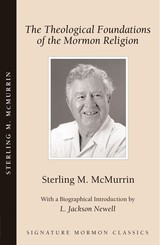 The Theological Foundations of the Mormon Religion
McMurrin
Signature Books, 2000 A Philosopher, Sterling M. McMurrin (1914-96) appreciated the similarities between Mormonism and Hellenistic Christianity. For instance, Church Fathers of the fifth century admired Plato, who taught that there is one God, coexistent with such eternal entities as Justice and Loveâ"to which Joseph Smith added Priesthood and Church. Where Augustine modified Plato, Mormonism would tend to side with his critic, the Stoic-leaning Pelagius. In this broad context, what is Mormonism's contribution to the overall pursuit of life's fundamental, ontological questions? Herein lies McMurrin's intentâ"an invitation to join him on a wide-ranging search for purpose. He finds his church's synthesis of heresy and orthodoxy to be refreshing and impressive in this light, in its treatment of evil, sin, and free will. Belief in a personal God may run counter to traditional faith, but it is nonetheless emotionally satisfying and accessible to the human imagination.
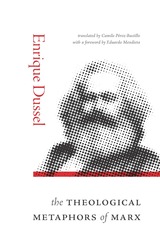 The Theological Metaphors of Marx
Enrique Dussel
Duke University Press, 2024 In The Theological Metaphors of Marx, Enrique Dussel provides a groundbreaking combination of Marxology, theology, and ethical theory. Dussel shows that Marx unveils the theology of capitalism in his critique of commodity fetishization. Capitalism constitutes an idolatry of the commodity that undergirds the capitalist expropriation of labor. Dussel examines Marx’s early writings on religion and fetishism and proceeds through what Dussel refers to as the four major drafts of Capital, ultimately situating Marx’s philosophical, economic, ethical, and historical insights in relation to the theological problems of his time. Dussel notes a shift in Marx’s underlying theological schema from a political critique of the state to an economic critique of the commodity fetish as the Devil, or anti-God, of modernity. Marx’s thought, impact, and influence cannot be fully understood without Dussel’s historic reinterpretation of the theological origins and implications of Marx’s critiques of political economy and politics.
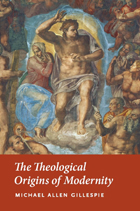 The Theological Origins of Modernity
Michael Allen Gillespie
University of Chicago Press, 2008 Exposing the religious roots of our ostensibly godless age, Michael Allen Gillespie reveals in this landmark study that modernity is much less secular than conventional wisdom suggests. Taking as his starting point the collapse of the medieval world, Gillespie argues that from the very beginning moderns sought not to eliminate religion but to support a new view of religion and its place in human life. He goes on to explore the ideas of such figures as William of Ockham, Petrarch, Erasmus, Luther, Descartes, and Hobbes, showing that modernity is best understood as a series of attempts to formulate a new and coherent metaphysics or theology. “Bringing the history of political thought up to date and situating it against the backdrop of contemporary events, Gillespie’s analyses provide us a way to begin to have conversations with the Islamic world about what is perhaps the central question within each of the three monotheistic religions: if God is omnipotent, then what is the place of human freedom?”—Joshua Mitchell, Georgetown University
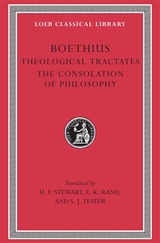 Theological Tractates. The Consolation of Philosophy
Translated by H. F. Stewart, E. K. Rand, and S. J. Tester
Harvard University Press A Christian polymath embraces reason against misfortune in poetry and prose.
Boethius (Boetius)—Anicius Manlius Severinus—Roman statesman and philosopher (ca. AD 480–524), was son of Flavius Manlius Boetius, after whose death he was looked after by several men, especially Memmius Symmachus. He married Symmachus’ daughter, Rusticiana, by whom he had two sons. All three men rose to high honors under Theodoric the Ostrogoth, but Boethius fell from favor, was tried for treason, wrongly condemned, and imprisoned at Ticinum (Pavia), where he wrote his renowned Consolation of Philosophy. He was put to death in 524, to the great remorse of Theodoric. Boethius was revered as if he were a saint and his bones were removed in 996 to the Church of S. Pietro in Ciel d’Oro, and later to the Cathedral. The tower in Pavia where he was imprisoned is still venerated.
Boethius was author of Latin translations of Aristotle, commentaries on various philosophical works, original works on logic, five books on music, and other works. His Consolation of Philosophy is the last example of purely literary Latin of ancient times—a mingling of alternate dialogue and poems. His Theological Tractates are also included in this volume.
Theology and Anthropology in the Book of Sirach
Bonifatia Gesche
SBL Press, 2020 New research on Sirach for scholars and students
The present volume of English and German essays includes the proceedings of an international conference held in Eichstaett, Germany, in 2017. Themes of creation, emotions, life, death, wisdom, knowledge, the individual and society, family, gender, mercy, justice, and freedom are but a few of the topics that contributors explore in this new collection. Essays explore the rich intertextual connections between Sirach and other biblical texts.
Features:
- Attention to theological distinctions presented in the Hebrew, Greek, Syriac, and Latin versions of the book of Sirach
- Examination of the reception of Sirach in the New Testament and the early modern era
- English abstracts for German-language essays and German abstracts for English-language essays
Theology and Literature in the Age of Johnson: Resisting Secularism
Melvyn New
University of Delaware Press, 2012 Theology and Literature in the Age of Johnson: Resisting Secularism contains seventeen essays exploring the complex relationships between literary intentions and theological concerns of authors writing in the second half of the eighteenth century. The diversity of literary forms and subjects, from Fielding and Richardson to Burke and Wollstonecraft, is matched by a diversity of approaches and theologies. To argue that the age “resisted secularism” is by no means to argue that resistance was blindly doctrinal or rigidly uniform. The many ways secularism could be resisted is the subject of the collection.
Published by University of Delaware Press. Distributed worldwide by Rutgers University Press.
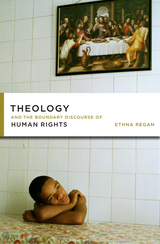 Theology and the Boundary Discourse of Human Rights
Ethna Regan
Georgetown University Press, 2010 What are human rights? Can theology acknowledge human rights discourse? Is theological engagement with human rights justified? What place should this discourse occupy within ethics? Ethna Regan seeks to answer these questions about human rights, Christian theology, and philosophical ethics. The main purpose of this book is to justify and explore theological engagement with human rights. Regan illustrates how that engagement is both ecumenical and diverse, citing the emerging engagement with human rights discourse by evangelical theologians in response to the War on Terror. The book examines where the themes and concerns of key modern theologians—Karl Rahner, J. B. Metz, Jon Sobrino, and Ignacio Ellacuría—converge with the themes and concerns of those committed to the advancement of human rights. Regan also critically engages with the “disdain” for rights discourse that is found in the postliberal critiques of John Milbank and Stanley Hauerwas. This interdisciplinary volume will be of interest to students and scholars in the fields of systematic theology, theological ethics, human rights, religion and politics, and political theory.
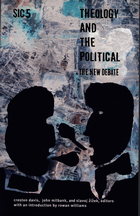 Theology and the Political: The New Debate, sic v
Creston Davis, John Milbank and Slavoj Žižek, eds.
Duke University Press, 2005 The essays in Theology and the Political—written by some of the world’s foremost theologians, philosophers, and literary critics—analyze the ethics and consequences of human action. They explore the spiritual dimensions of ontology, considering the relationship between ontology and the political in light of the thought of figures ranging from Plato to Marx, Levinas to Derrida, and Augustine to Lacan. Together, the contributors challenge the belief that meaningful action is simply the successful assertion of will, that politics is ultimately reducible to “might makes right.” From a variety of perspectives, they suggest that grounding human action and politics in materialist critique offers revolutionary possibilities that transcend the nihilism inherent in both contemporary liberal democratic theory and neoconservative ideology. Contributors. Anthony Baker, Daniel M. Bell Jr., Phillip Blond, Simon Critchley, Conor Cunningham, Creston Davis, William Desmond, Hent de Vries, Terry Eagleton, Rocco Gangle, Philip Goodchild, Karl Hefty, Eleanor Kaufman, Tom McCarthy, John Milbank, Antonio Negri, Catherine Pickstock, Patrick Aaron Riches, Mary-Jane Rubenstein, Regina Mara Schwartz, Kenneth Surin, Graham Ward, Rowan Williams, Slavoj Žižek
 Theology as an Ecclesial Discipline: Ressourcement and Dialogue
J. Augustine Di Noia
Catholic University of America Press, 2024 The practice of theology depends in part on asking the right questions. Not any sorts of questions, not idle questions, nor questions framed entirely by our own experience or the great issues of our times, but good theological questions focus the mind of the inquirer on the endlessly intelligible self-revelation of God to which the Sacred Scripture bears witness. Our own questions and the great questions of our times have a place, as long as they are purged of the ideological outlooks that can suppress or obscure the questions that the sacra pagina itself presses upon us.
Among the essays gathered in Theology as an Ecclesial Discipline, the first set directs the reader’s attention precisely to questions that trace the distinctive features of the nature of theology itself. What are the principles and scope of the field of theology as practiced by believers in an ecclesial context? Are historical-critical methods of exegesis compatible with a properly theological interpretation of the Scriptures? How can theology have a place in the academy as an intellectual discipline if the Magisterium seems to limit the scope of its inquiries? The second part considers a range of questions that preoccupy contemporary Protestant and Catholic theologians. Can the names Father, Son and Holy Spirit be replaced by more inclusive titles in doctrine and liturgy? By placing humanity at the center of theological investigation, is Christian humanism distinct from secular humanism? How can we be guilty of a sin committed by our first ancestors? Can the Christian vision of procreative human sexuality survive the cultural onslaught of the sexual revolution? The questions in the third part of this book arise from Catholic dialogue with non-Christian religions, or with other Christian communities, or with conceptions of a cosmos in ecological crisis. Is there a future for Catholic theology of religions? How can people who do not believe in Christ be saved? Is the cosmos a safe environment for human beings, or, alternatively, how can the cosmos be protected from human depredation? Can the concept of “church” stretch far enough to encompass Christian communities that see themselves as strictly local and independent bodies?
 Theology At The Void: Experience Language & Postmodern Challen
Thomas M. Kelly
University of Notre Dame Press, 2001 Theology at the Void explores the intersection of three central questions: What is human being? What is language? What is theology? Drawing on the writings of five major intellectuals from various religious and academic traditions, Thomas Kelly seeks to address these questions by tracing the emergence of a problem that arises when various modes of thought disagree on the relationship between experience, language, and theological inquiry. THOMAS M. KELLY is assistant professor of theology and Coordinator for the Study Center on Religion and Public Life at Saint Anselm College.
----------
"Thomas Kelly clearly and precisely situates the work of Karl Rahner within the contemporary context of postmodernism and deconstruction. In so doing, he makes a significant contribution to the conversation concerning the deepest philosophical and theological issues of our times." -Dennis Doyle, associate professor of religious studies, University of Dayton
"Theology at the Void makes a discerning argument for a theological retrieval of aspects of both modern and postmodern insights to articulate a theological perspective which takes seriously both the turn to the subject and the turn to language. Its analysis pinpoints a number of the key issues which postmodernity raises for contemporary theology, engages these seriously and offers a constructive, nontrivializing response." -Robert Masson, associate professor of theology, Marquette University and associate editor of Philosophy & Theology
"Modern theology qua modern begins with Schleiermacher's ‘turn to the subject' in terms of experience as the ground for theological affirmations. With the contemporary ‘linguistic turn' the modern turn has become problematic, especially with the postmodern understanding of language as constitutive of experience rather than as merely expressive. Accepting the critique of moderate postmodern thought, Kelly offers a critical retrieval of experience, as significantly conditioned without being totally constituted by language, for theological inquiry. Kelly joins other contemporary theologians in finding in Karl Rahner an anticipation of the postmodern concern with the formative power of language on experience. This book is a well-focused contribution to this contemporary discussion." -Michael J. Scanlon, O.S.A., Josephine C. Connelly Chair in Christian Theology, Villanova University
 Theology for a Liberating Church: The New Praxis of Freedom
Alfred T. Hennelly, SJ
Georgetown University Press, 1989 Freedom is a fundamental Christian theological category, as much a challenge to construct a new way of seeing oneself and others as it is an announcement of what Christ has already done for us in his death and resurrection. Liberation theology is, most simply, the effort to spell out what such freedom means for Christians in the twentieth and twenty-first centuries. This book has as its principle premise the conviction that if we are to construct a North American liberation theology we must begin listening to and understanding Latin American theology not so much as a model to be slavishly followed but as a challenge to our own cultural, political, and even religious assumptions. The focus thus is not so much on the theoretical meaning of Christian freedom but on its practice, and more exactly its praxis, that is to say the dialectic between theory and practice. After focusing on the creation and development of liberating theological methods and sources and, above all, the revitalization and renewal of structures that will contribute to the development of a liberated and liberating church, Fr. Hennelly ends with an analysis of the most recent and the most important vatican document on liberation theology, The Instruction of Christian Freedom and Liberation, which he sees as an acknowledgement by the universal church that the theme of liberation is central to the meaning of Christian theology.
Theology Needs Philosophy
Matthew L. Lamb
Catholic University of America Press, 2016 Theology Needs Philosophy brings together essays by leading theologians and philosophers on the fundamental importance of human reason and philosophy for Catholic theology and human cultures generally. This edited collection studies the contributions of reason, with its acquired wisdom, science, and scholarship, in five sections. Those sections are: (1) the inevitable presence and service of philosophy in theology; (2) the metaphysics of creation, nature, and the natural knowledge of God; (3) the history of Logos as reason in the fathers, in St. Thomas Aquinas, and Medieval Biblical commentaries; (4) the role of reason in Trinitarian theology, Christology, and Mariology; and finally (5) reason in the theology of Aquinas.
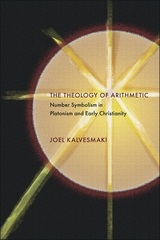 The Theology of Arithmetic: Number Symbolism in Platonism and Early Christianity
Joel Kalvesmaki
Harvard University Press, 2013 In the second century, Valentinians and other gnosticizing Christians used numerical structures and symbols to describe God, interpret the Bible, and frame the universe. In this study of the controversy that resulted, Joel Kalvesmaki shows how earlier neo-Pythagorean and Platonist number symbolism provided the impetus for this theology of arithmetic, and describes the ways in which gnosticizing groups attempted to engage both the Platonist and Christian traditions. He explores the rich variety of number symbolism then in use, among both gnosticizing groups and their orthodox critics, demonstrating how those critics developed an alternative approach to number symbolism that would set the pattern for centuries to come. Arguing that the early dispute influenced the very tradition that inspired it, Kalvesmaki explains how, in the late third and early fourth centuries, numbers became increasingly important to Platonists, who engaged in arithmological constructions and disputes that mirrored the earlier Christian ones.
 The Theology of Liberalism: Political Philosophy and the Justice of God
Eric Nelson
Harvard University Press, 2019 One of our most important political theorists pulls the philosophical rug out from under modern liberalism, then tries to place it on a more secure footing.
We think of modern liberalism as the novel product of a world reinvented on a secular basis after 1945. In The Theology of Liberalism, one of the country’s most important political theorists argues that we could hardly be more wrong. Eric Nelson contends that the tradition of liberal political philosophy founded by John Rawls is, however unwittingly, the product of ancient theological debates about justice and evil. Once we understand this, he suggests, we can recognize the deep incoherence of various forms of liberal political philosophy that have emerged in Rawls’s wake.
Nelson starts by noting that today’s liberal political philosophers treat the unequal distribution of social and natural advantages as morally arbitrary. This arbitrariness, they claim, diminishes our moral responsibility for our actions. Some even argue that we are not morally responsible when our own choices and efforts produce inequalities. In defending such views, Nelson writes, modern liberals have implicitly taken up positions in an age-old debate about whether the nature of the created world is consistent with the justice of God. Strikingly, their commitments diverge sharply from those of their proto-liberal predecessors, who rejected the notion of moral arbitrariness in favor of what was called Pelagianism—the view that beings created and judged by a just God must be capable of freedom and merit. Nelson reconstructs this earlier “liberal” position and shows that Rawls’s philosophy derived from his self-conscious repudiation of Pelagianism. In closing, Nelson sketches a way out of the argumentative maze for liberals who wish to emerge with commitments to freedom and equality intact.
The Theology of Louis Massignon
Christian Krokus
Catholic University of America Press, 2017 In The Theology of Louis Massignon, author Christian Krokus argues that Louis Massignon’s achievements in Christian-Muslim understanding, his activism on behalf of Muslim immigrants, refugees, and Middle Eastern Christians, as well as his developing understanding of Islam must be understood in the light of his Catholic convictions in relation to God, Christ, and the Church. With ample references to primary works, many translated into English for the first time, Krokus offers a comprehensive account of the main points of Massignon’s religious thought that will prove essential to theologians and historians working on questions of Christian-Muslim dialogue, comparative theology, and religious pluralism.
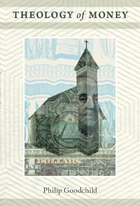 Theology of Money
Philip Goodchild
Duke University Press, 2009 Theology of Money is a philosophical inquiry into the nature and role of money in the contemporary world. Philip Goodchild reveals the significance of money as a dynamic social force by arguing that under its influence, moral evaluation is subordinated to economic valuation, which is essentially abstract and anarchic. His rigorous inquiry opens into a complex analysis of political economy, encompassing markets and capital, banks and the state, class divisions, accounting practices, and the ecological crisis awaiting capitalism. Engaging with Christian theology and the thought of Carl Schmitt, Georg Simmel, Karl Marx, Adam Smith, and many others, Goodchild develops a theology of money based on four contentions, which he elaborates in depth. First, money has no intrinsic value; it is a promise of value, a crystallization of future hopes. Second, money is the supreme value in contemporary society. Third, the value of assets measured by money is always future-oriented, dependent on expectations about how much might be obtained for those assets at a later date. Since this value, when realized, will again depend on future expectations, the future is forever deferred. Financial value is essentially a degree of hope, expectation, trust, or credit. Fourth, money is created as debt, which involves a social obligation to work or make profits to repay the loan. As a system of debts, money imposes an immense and irresistible system of social control on individuals, corporations, and governments, each of whom are threatened by economic failure if they refuse their obligations to the money system. This system of debt has progressively tightened its hold on all sectors and regions of global society. With Theology of Money, Goodchild aims to make conscious our collective faith and its dire implications.
Theology of Peter Damian
Patricia Ranft
Catholic University of America Press, 2012 In the first comprehensive work based wholly on critical editions of Damian's writings, Ranft explores all 180 letters of Damian and his vita of Romuald.
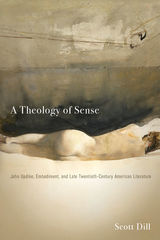 A Theology of Sense: John Updike, Embodiment, and Late Twentieth-Century American Literature
Scott Dill
Ohio State University Press, 2018 Scott Dill’s A Theology of Sense: John Updike, Embodiment, and Late Twentieth-Century American Literature brings together theology, aesthetics, and the body, arguing that Updike, a central figure in post-1945 American literature, deeply embeds in his work questions of the body and the senses with questions of theology. Dill offers new understandings not only of the work of Updike—which is importantly being revisited since the author’s death in 2009—but also new understandings of the relationship between aesthetics, religion, and physical experience. Dill explores Updike’s unique literary legacy in order to argue for a genuinely postsecular theory of aesthetic experience. Each chapter takes up one of the five senses and its relation to broader theoretical concerns: affect, subjectivity, ontology, ethics, and theology. While placing Updike’s work in relation to other late twentieth-century American writers, Dill explains their notions of embodiment and uses them to render a new account of postsecular aesthetics. No other novelist has portrayed mere sense experience as carefully, as extensively, or as theologically—repeatedly turning to the doctrine of creation as his stylistic justification. Across this examination of his many stories, novels, poems, and essays, Dill proves that Updike forces us to reconsider the power of literature to revitalize sense experience as a theological question.
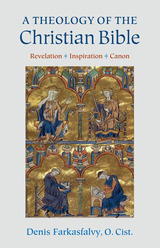 A Theology of the Christian Bible: Revelation - Inspiration - Canon
Denis Farkasfalvy
Catholic University of America Press, 2018 A Theology of the Christian Bible is built upon the thesis that divine revelation, the inspiration and canonization of Scripture should be viewed as “sequentially linked movements” of a single process wherein God reveals his Word in history and ensures permanent accessibility of revelation for his People, both of Israel and of the Church. The starting point is the view expressed in the Second Vatican Council’s document Dei Verbum that revelation consists of the “words and realities” of Salvation History. This marks a shift away from the neo-scholastic concept that approached revelation primarily as a set of propositional truths. Farkasfalvy begins with the notion of revelation as a historical process: God reveals his Word in a “salvation history,” which culminates in the Incarnation. The transmission of revelation always involves human mediation by chosen individuals or, in the language of the biblical and patristic tradition, “Prophets and Apostles.” Farkasfalvy then moves on to review some of the major contributors to the theology of inspiration around the time of Vatican II (Bea, Rahner, Alonso-Schökel), the teaching of Dei Verbum proper, and finally the 2014 document of the Pontifical Biblical Commission and biblical inspiration and the truth of the Bible, treating each of these in its individual context. According to Farkasfalvy, the theology of inspiration was greatly handicapped by the neo-scholastic notion of God as a “literary author” of the scriptural texts. Advocating God as true and genuine “author” of Scripture, but in a non-literary sense, Farkasfalvy also reviews afresh the tradition inspiration-incarnation analogy. Scripture should be thought of in light of God progressively revealing himself in limited and located contexts to chosen human beings, through whom revelation is transmitted in verbal and, eventually, written form. God guides the complex compositional processes of the biblical books so that his word becomes accessibly and permanently preserved in writing for his people, the Church. The final chapters of A Theology of the Christian Bible take up the extension of these dynamics into canonization. These largely exegetical and historical chapters focus on the transmission of the revelation in Christ through both Testaments by means of Jesus’ Apostles, embracing the Hebrew Scriptures and setting in motion the formation and, in early patristics, the canonization of the New Testament.
Theology of the Hebrew Bible, Volume 1: Methodological Studies
Marvin A. Sweeney
SBL Press, 2019 Diverse approaches to biblical theology
This volume presents a collection of studies on the methodology for conceiving the theological interpretation of the Hebrew Bible among Jews and Christians as well as the treatment of key issues such as creation, the land of Israel, and divine absence. Contributors include Georg Fischer, SJ, David Frankel, Benjamin J. M. Johnson, Soo J. Kim, Wonil Kim, Jacqueline E. Lapsley, Julia M. O’Brien, Dalit Rom-Shiloni, Marvin A. Sweeney, and Andrea L. Weiss.
Features:
- Examination of metaphor, repentance, and shame in the presence of God
- Ten essays addressing the nature of biblical theology from a Jewish, Christian, or critical perspective
- Discussion of the changes that have taken place in the field of biblical theology since World War II
 Theology of the Hebrew Bible, Volume 2: Texts, Readers, and Their Worlds
Soo Kim Sweeney
SBL Press, 2024 This follow-up to Theology of the Hebrew Bible, Volume 1: Methodological Studies, focuses on readers’ engagement with the text and their communities. Part 1 offers fresh interpretations of divine images and theological concepts drawn from various theophanies in the text. Part 2 focuses on how these insights can form new overarching structures, serving as reading strategies or foundations for alternative theologies. Part 3 emphasizes the bond between readers and their communities, highlighting the active participation of both ancient and modern readers through an analysis of past literature. Contributors, each an expert in their field, include Rachel Adelman, Samuel E. Balentine, Shelly L. Birdsong, Ginny Brewer-Boydston, Johanna Etzberger, Frances Flannery, David Frankel, Barry R. Huff, Hyun Chul Paul Kim, Barbara Leung Lai, J. Richard Middleton, Hye Kyung Park, Kris Sonek, Brent A. Strawn, David E. S. Stein, Marvin A. Sweeney, Soo Kim Sweeney, Joseph Sykora, Daniel C. Timmer, and Beat Weber. This collection of essays guides readers, including those well-versed in theology, to explore innovative and unexpected depictions of divine beings and how human characters respond to them.
 The Theology of Thomas Aquinas
Rik Van Nieuwenhove
University of Notre Dame Press, 2005
A Choice Outstanding Academic Book
"Readers will be grateful for this excellent comprehensive survey of Aquinas' theology. It is a compendium in the best sense of the word, both introduction for beginners and a reliable source of information for advanced scholars. Even experts in Thomist thought will highly appreciate the great number of original and stimulating essays which provide new views and interpretations of seemingly well known texts." --Ulrich Horst, O.P., Ludwig Maximilian University
This comprehensive volume provides an in-depth overview of every major aspect of Thomas Aquinas's theology. Contributors offer fresh and compelling readings of Aquinas on the Trinity, creation theology, theory of analogy, anthropology, predestination and human freedom, evil and original sin, Christology and grace, soteriology, eschatology, sacramentology, ecclesiology, moral theology, the relation between theology and philosophy, and scriptural exegesis.
Contributors toThe Theology of Thomas Aquinascome from seven different countries and a variety of specialties within the discipline of theology. Their diverse perspectives add considerable merit to the depth and breadth of this project. Contributors both outline the thought of Aquinas in its own right and bring it into dialogue with present theological concerns. The high quality of these essays make this volume a valuable reference tool.
 Theology without Borders: Essays in Honor of Peter C. Phan
Leo D. Lefebure, Editor. Foreword byThomas Banchoff
Georgetown University Press, 2022 A comprehensive series of essays exploring Peter C. Phan’s groundbreaking work to widen Christian theology beyond the Western world Peter C. Phan’s wide-ranging contributions to theology and his pioneering work on religious pluralism, migration, and Christian identity have made a global impact on the field. The essays in Theology without Borders offer a variety of perspectives across Phan’s fundamental work in eschatology, world christianity, interreligious dialogue, and much more. Together, these essays offer a comprehensive assessment of Phan’s groundbreaking work across a range of theological fields. Included in the conversation are discussions of world Christianity and migration, Christian identity and religious pluralism, Christian theology in Asia, Asian American theology, eschatology, and Phan’s lasting legacy. Theology without Borders provides a welcome overview for anyone interested in the career of Peter C. Phan, his body of work, and its influence.
 Theo-Poetics: Hans Urs von Balthasar and the Risk of Art and Being
Anne M. Carpenter
University of Notre Dame Press, 2015 Swiss theologian Hans Urs von Balthasar (1905–1988) originated much of twentieth- and twenty-first-century theology’s renewed interest in aesthetics. Von Balthasar’s theology is both poetic and philosophical, and while this combination is often recognized, it calls for an explanation. In Theo-Poetics: Hans Urs von Balthasar and the Risk of Art and Being, Anne M. Carpenter explores von Balthasar's use of poetry and poetic language, and she offers a detailed analysis of his philosophical presuppositions. Carpenter argues that von Balthasar uses poets and poetic language to make theological arguments because this poetic way of speaking expresses metaphysical truth without reducing one to the other.
Carpenter begins with von Balthasar's very early interests in music, literature, and philosophy, in particular his work, Apocalypse of the German Soul. She explores Glory of the Lord and the trilogy, moving through his despair over the possibility of reconciling art and theology. She uncovers the major characteristics of von Balthasar's metaphysical thinking, discussing his interactions with Thomas Aquinas, Karl Barth, and Martin Heidegger to firmly link Christology, metaphysics, and the expressiveness of language. The book concludes by marshaling its themes into a focused evaluation of von Balthasar's "redeemed" theo-poetic as it comes to expression in the poetry of G. M. Hopkins. Carpenter resituates and reevaluates Hopkins's poetry in a new context, placing him in the school of Aquinas rather than Scotus, and shows us how metaphysics is necessary for a vigorous understanding of language.
"How do we value the theological in artistic works? In this book Anne Carpenter creates a significant map to the expansive landscape proposed by theological aesthetics. As she reenacts the “interplay” of poetry and philosophy yielding theology in von Balthasar and his interlocutors, Carpenter points toward the incarnated beauty of human creativity and the inherent unity of reason and heart. Through her careful 'untangling' of the role of the poetic in making theologizing possible, Carpenter confirms gravitas on the utterances of artists known and unknown, whose creative abundance overflows providing us new and important vistas into the in-breaking glory of God." —Cecilia González-Andrieu, Loyola Marymount University
"This is a beautifully written work engaging von Balthasar's attempt to wed aesthetics back into the essence of theology. Carpenter presents a sophisticated and creative study of the importance of the aesthetics of the written word in order to reveal the importance of von Balthasar’s project but also to advance it. The work presents a clear overview of the heart of von Balthasar’s work, but also a fresh application of it through an analysis of poetry. The book provides a rich source for contemplating the eternal Word, God’s most creative act of poetry uttered eternally." —John Dadosky, Regis College/University of Toronto
"Anne M. Carpenter turns a lot of difficult and abstruse research about Hans Urs von Balthasar in the scholarly literature into a lively and readable book. The volume achieves the goal of explaining the poetic form of von Balthasar's writing, tracing it back to the centrality of the concept of expression in his philosophical theology. The special value of the book is that it explains new developments of von Balthasar and recent objections to von Balthasar in a way that makes them accessible, gathering a lot of diverse scholarship into a single quite short book." —Francesca Murphy, University of Notre Dame
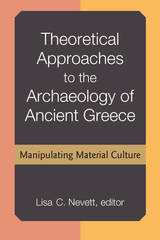 Theoretical Approaches to the Archaeology of Ancient Greece: Manipulating Material Culture
Lisa C. Nevett, Editor
University of Michigan Press, 2017 In the modern world, objects and buildings speak eloquently about their creators. Status, gender identity, and cultural affiliations are just a few characteristics we can often infer about such material culture. But can we make similar deductions about the inhabitants of the first millennium BCE Greek world? Theoretical Approaches to the Archaeology of Ancient Greece offers a series of case studies exploring how a theoretical approach to the archaeology of this area provides insight into aspects of ancient society.
An introductory section exploring the emergence and growth of theoretical approaches is followed by examinations of the potential insights these approaches provide. The authors probe some of the meanings attached to ancient objects, townscapes, and cemeteries, for those who created, and used, or inhabited them.
The range of contexts stretches from the early Greek communities during the eighth and seventh centuries BCE, through Athens between the eighth and fifth centuries BCE, and on into present day Turkey and the Levant during the third and second centuries BCE. The authors examine a range of practices, from the creation of individual items such as ceramic vessels and figurines, through to the construction of civic buildings, monuments, and cemeteries. At the same time they interrogate a range of spheres, from craft production, through civic and religious practices, to funerary ritual.
Theoretical Aspects of Bantu Grammar 1
Edited by Sam Mchombo
CSLI, 1993 The study of Bantu languages of sub-Saharan Africa has provided the basis for significant contributions to research in linguistics. In recent years they have been used to advance morphological as well as syntactic theory, and in the study of interface relations in grammatical theory. The papers assembled in this volume, contributed by leading scholars in Bantu and general linguistics, deal with various aspects of the structure of Bantu languages.
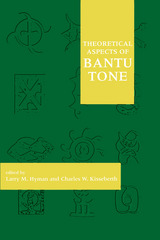 The Theoretical Aspects of Bantu Tone
Edited by Larry M. Hyman and Charles Kisseberth
CSLI, 1998 This book brings together a collection of papers focusing on the tonal systems of the Bantu languages of sub-Saharan Africa. These papers are alike in their attempt to fuse the description of Bantu tone with linguistic theory, but at the same time reflect a range of such theoretical perspectives (autosegmental phonology, lexical phonology, Optimality Theory, Optimal Domains Theory). Much new descriptive material is to be found in this collection, as well as attempts to bring Bantu tonology to bear on critical issues of phonological theory. This collection of papers stands as a testimony to the benefits to be gained from the marriage of theory and description.
This book provides new theoretical insights and analyses of the complexities known to characterize Bantu tone systems. Three of the articles indicate not only how one can apply the concepts of rapidly developing Optimality Theory, but also how the latter can be shaped by the unique features found in these languages. While two of the contributions use standard OT, the third by Cassimjee and Kisseberth provides a detailed introduction of Optimal Domains Theory (ODT) and its application to a number of Bantu tone systems. These and other articles provide new insights into the treatment of long-distance tonal effects, tonal domains, depressor consonants, and other issues known through the autosegmental and metrical literature on tone. The collection features contributors from both sides of the Atlantic and contributions that have both synchronic and diachronic significance for the field.
The Theoretical Dimensions of Henry James
John Carlos Rowe
University of Wisconsin Press, 1985 Rowe examines James from the perspectives of the psychology of literary influence, feminism, Marxism, psychoanalysis, literary phenomenology and impressionism, and reader-response criticism, transforming a literary monument into the telling point of intersection for modern critical theories.
Theoretical Issues in Literary History
David Perkins
Harvard University Press, 1991 Literary history, the dominant form of literary scholarship throughout the nineteenth century, is currently recapturing the imaginations of a new generation of scholars eager to focus on the context of literature after a half-century or more of “close” readings of isolated texts. This book represents current thinking on some of the theoretical issues and dilemmas in the conception and writing of literary history, expressed by a group of scholars from North America, Europe, and Australia. They consider afresh a broad range of topics: the role of literary history in “new” societies, the problem of finding a starting point for literary history, the problem of literary classification, problems of ideology, of institutional mediation, periodization, and the attack on literary history.
 Theoretical Issues in Sign Language Research, Volume 1: Linguistics
Edited by Susan D. Fischer and Patricia Siple
University of Chicago Press, 1990 Only recently has linguistic research recognized sign languages as legitimate human languages with properties analogous to those cataloged for French or Navajo, for example. There are many different sign languages, which can be analyzed on a variety of levels—phonetics, phonology, morphology, syntax, and semantics—in the same way as spoken languages. Yet the recognition that not all of the principles established for spoken languages hold for sign languages has made sign languages a crucial testing ground for linguistic theory.
Edited by Susan Fischer and Patricia Siple, this collection is divided into four sections, reflecting the traditional core areas of phonology, morphology, syntax, and semantics. Although most of the contributions consider American Sign Language (ASL), five treat sign languages unrelated to ASL, offering valuable perspectives on sign universals. Since some of these languages or systems are only recently established, they provide a window onto the evolution and growth of sign languages.
 Theoretical Issues in Sign Language Research, Volume 2: Psychology
Edited by Patricia Siple and Susan D. Fischer
University of Chicago Press, 1991 The recent recognition of sign languages as legitimate human languages has opened up new and unique ways for both theoretical and applied psycholinguistics and language acquisition have begun to demonstrate the universality of language acquisition, comprehension, and production processes across a wide variety of modes of communication. As a result, many language practitioners, teachers, and clinicians have begun to examine the role of sign language in the education of the deaf as well as in language intervention for atypical, language-delayed populations.
This collection, edited by Patricia Siple and Susan D. Fischer, brings together theoretically important contributions from both basic research and applied settings. The studies include native sign language acquisition; acquisition and processing of sign language through a single mode under widely varying conditions; acquisition and processing of bimodal (speech and sign) input; and the use of sign language with atypical, autistic, and mentally retarded groups.
All the chapters in this collection of state-of-the-art research address one or more issues related to universality of language processes, language plasticity, and the relative contributions of biology and input to language acquisition and use.
 Theoretical Perspectives on Fan Scholarship in the Franchise Era
Sophie Charlotte van de Goor
Amsterdam University Press, 2024 This book is a practical and theoretical guide for anyone interested in researching popular media, popular culture, audiences, and fans. Unlike most books, Theoretical Perspectives does not talk about media texts or fan communities. Instead, it critically explores the workings of fan scholarship: research on popular media and fan culture done by scholars who are often fans themselves, showing and challenging how we have constructed certain ideas about what fans and fandom are, and how to study them/as a fan.
Analysing scholarship on two transmedia franchises (The Marvel Cinematic Universe and the BBC’s Sherlock) with the help of extensive international participant discussion, Theoretical Perspectives explores and unravels established, popular theoretical frameworks and value systems on taste and legitimacy, subversion, filtering and safe spaces, neoliberal capitalist realism, and fannish dispositions to offer new approaches for anyone who wants to create a better understanding of fans, fandom, and themselves.
Theoretical Principles in Astrophysics and Relativity
Norman R. Lebovitz, William H. Reid, and Peter O. Vandervoort
University of Chicago Press, 1981 "This is a remarkable book: a symposium proceedings volume that will also function as a graduate-level text. Dedicated to the great theorist S. Chandrasekhar, the book consists of ten well-written chapters that cover the essential tools of theoretical astrophysics. The first half of the volume is concerned with the theory of how stars work (structure, stability, rotation, magnetism, dynamics) and the latter half is mainly a survey of relativistic astrophysics. . . . Read it for a broad-brush view of what theorists are up to now and how they solve problems."—Journal of the British Astronomical Association
"The book as a whole should be a gift from every research supervisor to every new graduate student in theoretical astronomy."—D. W. Sciama, Science
 Theories and Narratives: Reflections on the Philosophy of History
Alex Callinicos
Duke University Press, 1995 At a time when philosophy of history is decidedly out of fashion, Theories and Narratives explores the relationship between historical writing and theoretical understanding and seeks to establish the legitimate scope of large-scale theories to grasp historical processes as a whole.
Pursuing this objective, Alex Callinicos critically confronts a number of leading attempts to reconceptualize the meaning of history, including Francis Fukuyama’s rehabilitation of Hegel’s philosophy of history and the postmodernist efforts of Hayden White and others to deny the existence of a past independent of our representations of it. In these cases philosophical arguments are pursued in tandem with discussions of historical interpretations or, respectively, Stalinism and the Holocaust. Leading theories of history—Marx’s and Weber’s—are then examined in the context of recent work by writers such as Michael Mann, W. G. Runciman, and Robert Brenner
Finally, the politics of historical theory is explored in a discussion of Marxism’s claims to be a universal theory of human progress. Contradicting current fashion, Callinicos rebuts the claims made by many postmodernists that Marxism is inherently Eurocentric in both its conceptual structures and its political practice. Marx’s project of human emancipation, he concludes, still define our political horizons.
Theories and Narratives will interest all readers for whom the role of history in the understanding of contemporary civilizations is an essential issue.
Theories and Things
W. V. Quine
Harvard University Press, 1981 Here are the most recent writings, some of them unpublished, of the preeminent philosopher of our time. Philosophical reflections on language are brought to bear upon metaphysical and epistemological questions such as these: What does it mean to assume objects, concrete and abstract? How do such assumptions serve science? What is the empirical content of a scientific theory? Further essays deal with meaning, moral values, analytical philosophy and its history, metaphor, the nature of mathematics; several are concerned with logic; and there are essays on individual philosophers. The volume concludes with some general reflections on the contemporary scene and two playful pieces on the Times Atlas and H. L. Mencken.
W. V. Quine is always, whatever his subject, an elegant writer, witty, precise, and forceful. Admirers of his earlier books will welcome this new volume.
Theories of Africans: Francophone Literature and Anthropology in Africa
Christopher L. Miller
University of Chicago Press, 1990 "Situating literature and anthropology in mutual interrogation, Miller's...book actually performs what so many of us only call for. Nowhere have all the crucial issues been brought together with the sort of critical sophistication it displays."—Henry Louis Gates, Jr.
". . . a superb cross-disciplinary analysis."—Y. Mudimbe
Theories of Art Today
Edited by Noel Carroll
University of Wisconsin Press, 2000 What is art? The contributors to Theories of Art Today address the assertion that the term “art” no longer holds meaning. They explore a variety of issues including: aesthetic and institutional theories of art, feminist perspectives on the philosophy of art, the question of whether art is a cluster concept, and the relevance of tribal art to philosophical aesthetics. Contributors to this book include such distinguished philosophers and historians as Arthur Danto, Joseph Margolis, and George Dickie.
 Theories of Dependent Foreign Policy and the Case of Ecuador in the 1980s
Jeanne A. K. Hey
Ohio University Press, 1995 How do economic weakness and dependence influence foreign policy decisions and behavior in third world countries? Theories in Dependent Foreign Policy examines six foreign policy theories: compliance, consensus, counterdependence, realism, leader preferences and domestic politics, and each is applied to a series of case studies of Ecuador’s foreign policy during the 1980s under two regimes: Osvaldo Hurtado (1981-1984) and his successor León Febres Cordero (1984-1988). Hey shows that Ecuador during this period represented the third world in many ways. It was a new democracy, having just emerged from years of military rule, extremely indebted to the West, and dependent on primary product export economy that relied heavily on importers, especially the United States. Jeanne Hey finds that some of the most popular and enduring theories in western research, such as realism and compliance, poorly account for Ecuadorian foreign policy. She explains that poor countries like Ecuador have substantial foreign policy latitude in the diplomatic area. Drawing on archival research and interviews with policy makers including Presidents Hurtado and Febres Cordero, Dr. Hey convincingly argues that many of the traditional foreign policy theories do not “fit” dependent states, and inadequately account for the complexity of foreign policy in the third world.
 Theories of Distributive Justice
John E. Roemer
Harvard University Press, 1996 Equally at home in economic theory and political philosophy, John Roemer has written a unique book that critiques economists’ conceptions of justice from a philosophical perspective and philosophical theories of distributive justice from an economic one. He unites the economist’s skill in constructing precise, axiomatic models with the philosopher’s in exploring the assumptions of those models. His synthesis will enable philosophers and economists to engage each other’s ideas more fruitfully.
Roemer first shows how economists’ understanding of the fairness of various resource allocation mechanisms can be enriched. He extends the economic theory of social choice to show how individual preferences can be aggregated into social preferences over various alternatives. He critiques the standard applications of axiomatic bargaining theory to distributive justice, showing that they ignore information on available resources and preference orderings. He puts these variables in the models, which enable him to generate resource allocation mechanisms that are more consonant with our intuitions about distributive justice. He then critiques economists’ theories of utilitarianism and examines the question of the optimal population size in a world of finite resources.
Roemer explores the major new philosophical concepts of the theory of distributive justice—primary goods, functionings and capability, responsibility in its various forms, procedural versus outcome justice, midfare—and shows how they can be sharpened and clarified with the aid of economic analysis. He critiques and extends the ideas of major contemporary theories of distributive justice, including those of Rawls, Sen, Nozick, and Dworkin. Beginning from the recent theories of Arneson and G. A. Cohen, he constructs a theory of equality of opportunity. Theories of Distributive Justice contains important and original results, and it can also be used as a graduate-level text in economics and philosophy.
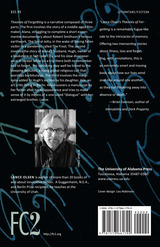 Theories of Forgetting
Lance Olsen
University of Alabama Press, 2014 Theories of Forgetting is concerned with how words matter, the materiality of the page, and how a literary work might react against mass reproduction and textual disembodiment in the digital age--right from its use of two back covers (one "upside down" and one "right-side up") that allow the reader to choose which of the novel's two narratives to privilege.
Theories of Forgetting is a narrative in three parts. The first is the story of Alana, a filmmaker struggling to complete a short documentary about Robert Smithson’s famous earthwork, The Spiral Jetty, located where the Great Salt Lake meets the desert. Alana falls victim to a pandemic called The Frost, whose symptoms include an increasing sensation of coldness and growing amnesia. The second involves Alana’s husband, Hugh, owner of a rare-and-used bookstore in Salt Lake City, and his slow disappearance across Jordan while on a trip both to remember and to forget Alana’s death. The third involves marginalia added to Hugh’s section by his daughter, Aila, an art critic living in Berlin. Aila discovers a manuscript by her father after his disappearance and tries to make sense of it by means of a one-sided “dialogue” with her brother, Lance.
Each page of the novel is divided in half. Alana’s narrative runs across the top of the page, from back to front, while Hugh’s and his daughter’s tale runs “upside down” across the bottom of the page, from front to back. How a reader initially happens to pick up Theories of Forgetting determines which narrative is read first, and thereby establishing the reader’s meaning-making of the novel.
Theories of Illness: A World Survey
George Peter Murdock
University of Pittsburgh Press, 1980
An important contribution to medical anthropology, this work defines the principal causes if illness that are reported throughout the world, distinguishing those involving natural causation from the more widely prevalent hypotheses advancing supernatural explanations.
Theories of Imperialism
Wolfgang J. Mommsen
University of Chicago Press, 1982 "In recent years the discussion of imperialism has become so compartmentalized that it is difficult for somebody who is not directly involved to put the often polemical discussion and the various scientific and political positions forward into a relevant context. Mommsen's survey is an excellent guide."—German Studies, on the German edition.
"Theories of Imperialism is the most succinct, fairest, and most sophisticated statement I have seen of the range of theories of imperialism. Each set of theorists is come at in their own terms, described fairly, and summarized fully. The book is objective, readable, and short."—Robin W. Winks, Yale University
 Theories Of The New Class: Intellectuals And Power
Lawrence Peter King
University of Minnesota Press, 2004 Demonstrates the centrality of thinking about intellectual class formation to social theory Old as the notion of the “New Class” is (the term was coined by anarchist Mikhail Bakunin around 1870), the idea of the ascendancy of an intellectual elite continues to engage, and perplex, social theorists. In Theories of the New Class, Iván Szelényi, one of the most incisive and respected analysts of the intellectual class, and his colleague Lawrence King put New Class theories into a broad historical framework for the first time. Addressing the intellectual history of Marxism and socialism, theories of the increasing role of the state and technocratic elites in capitalism, and theories of contemporary social change, King and Szelényi’s work clearly links the centrality of thinking about intellectual class formation to a variety of theoretical and political projects that have shaped social theory and influenced political realities over the past century.King and Szelényi show that the idea of the New Class has stubbornly entered and reentered the agenda of critical social theorizing throughout the last century. Indeed, they interpret that the last century as a history of projects by different groups of the highly educated—factions of intellectuals, bureaucrats, technocrats, managers, and the left-wing humanistic intelligentsia—to gain ultimate power. A rare empirical discussion of theory, Theories of the New Class invigorates class theories by grounding them in contemporary issues; at the same time, it uses modern polemics to revitalize historical debates on the origins of capitalism.
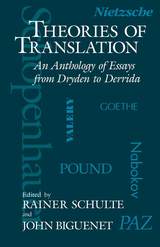 Theories of Translation: An Anthology of Essays from Dryden to Derrida
Edited by John Biguenet and Rainer Schulte
University of Chicago Press, 1992 Spanning the centuries, from the seventeenth to the twentieth, and ranging across cultures, from England to Mexico, this collection gathers together important statements on the function and feasibility of literary translation. The essays provide an overview of the historical evolution in thinking about translation and offer strong individual opinions by prominent contemporary theorists.
Most of the twenty-one pieces appear in translation, some here in English for the first time and many difficult to find elsewhere. Selections include writings by Scheiermacher, Nietzsche, Ortega, Benjamin, Pound, Jakobson, Paz, Riffaterre, Derrida, and others.
A fine companion to The Craft of Translation, this volume will be a valuable resource for all those who translate, those who teach translation theory and practice, and those interested in questions of language philosophy and literary theory.
Theories of Vision from Al-kindi to Kepler
David C. Lindberg
University of Chicago Press, 1981 Kepler's successful solution to the problem of vision early in the seventeenth century was a theoretical triumph as significant as many of the more celebrated developments of the scientific revolution. Yet the full import of Kepler's arguments can be grasped only when they are viewed against the background of ancient, medieval, and Renaissance visual theory. David C. Lindberg provides this background, and in doing so he fills the gap in historical scholarship and constructs a model for tracing the development of scientific ideas.
David C. Lindberg is professor and chairman of the department of the history of science at the University of Wisconsin, Madison.
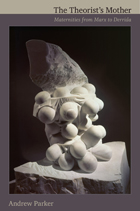 The Theorist's Mother
Andrew Parker
Duke University Press, 2012 In The Theorist's Mother one of our subtlest literary theorists turns his attention to traces of the maternal in the lives and works of canonical male critical theorists. Noting how the mother is made to disappear both as the object of theory and as its subject, Andrew Parker focuses primarily on the legacies of Marx and Freud, who uniquely constrain their would-be heirs to "return to the origin" of each founding figure's texts. Analyzing the effects of these constraints in the work of Lukács, Lacan, and Derrida, among others, Parker suggests that the injunction to return transforms the history of theory into a form of genealogy, meaning that the mother must somehow be involved in this process, even if, as in Marxism, she seems wholly absent, or if her contributions are discounted, as in psychoanalysis. Far from being marginalized, the mother shows herself throughout this book to be inherently multiple and therefore never simply who or what theory may want her to be. In a provocative coda, Parker considers how theory’s mother troubles will be affected retroactively by scientific advances that make it impossible to presume the mother's gender.
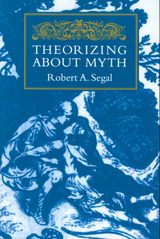 Theorizing about Myth
Robert A. Segal
University of Massachusetts Press, 1999 For two hundred years the subject of myth—its origin, function, and significance—has been addressed again and again, first by theologians and philosophers and then by anthropologists, sociologists, and psychologists. From the outset the topic has sparked intense debate, with differing opinions expressed on everything from issues of epistemology and methodology to the meaning of "myth" itself. In this collection of essays, Robert A. Segal surveys the contours of this ongoing discussion, comparing and evaluating the leading theories of myth. Among the theorists discussed are Edward Tylor, William Robertson Smith, James Frazer, Jane Harrison, S. H. Hooke, Mircea Eliade, Rudolf Bultmann, Hans Jonas, Sigmund Freud, C. G. Jung, Joseph Campbell, Claude Lévi-Strauss, and Hans Blumenberg. Author and editor of numerous books and articles in the fields of theories of myth and theories of religion, Segal has developed a reputation as a preeminent proponent of a social-scientific approach to the study of both. The essays in this book represent some of the best of his writing on myth over the past ten years.
THEORIZING ANGLO-SAXON STONE SCULPTURE
CATHERINE E. KARKOV
West Virginia University Press, 2003 Theorizing Anglo-Saxon Stone Sculpture significantly advances the complex study of Anglo-Saxon carved monuments, such as the Ruthwell Cross, by adopting more explicit theoretical approaches to the subject. Scholars included here are explicit in describing how their approaches complement (or, more often, contradict) the work of others. This book comes as a shot across the bow of these vessels. Contributors include the best scholars on this subject matter in England, Ireland, and America.
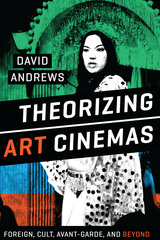 Theorizing Art Cinemas: Foreign, Cult, Avant-Garde, and Beyond
By David Andrews
University of Texas Press, 2013 The term “art cinema” has been applied to many cinematic projects, including the film d’art movement, the postwar avant-gardes, various Asian new waves, the New Hollywood, and American indie films, but until now no one has actually defined what “art cinema” is. Turning the traditional, highbrow notion of art cinema on its head, Theorizing Art Cinemas takes a flexible, inclusive approach that views art cinema as a predictable way of valuing movies as “art” movies—an activity that has occurred across film history and across film subcultures—rather than as a traditional genre in the sense of a distinct set of forms or a closed historical period or movement. David Andrews opens with a history of the art cinema “super-genre” from the early days of silent movies to the postwar European invasion that brought Italian Neorealism, the French New Wave, and the New German Cinema to the forefront and led to the development of auteur theory. He then discusses the mechanics of art cinema, from art houses, film festivals, and the academic discipline of film studies, to the audiences and distribution systems for art cinema as a whole. This wide-ranging approach allows Andrews to develop a theory that encompasses both the high and low ends of art cinema in all of its different aspects, including world cinema, avant-garde films, experimental films, and cult cinema. All of these art cinemas, according to Andrews, share an emphasis on quality, authorship, and anticommercialism, whether the film in question is film festival favorite or a midnight movie.
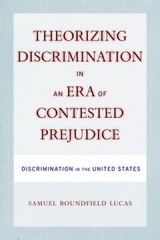 Theorizing Discrimination in an Era of Contested Prejudice: Discrimination in the United States
Samuel Roundfield Lucas
Temple University Press, 2009 Despite several decades of attention, there is still no consensus on the effects of racial or sexual discrimination in the United States. In this landmark work, the well-known sociologist Samuel Lucas shows how discrimination is not simply an action that one person performs in relation to another individual, but something far more insidious: a pervasive dynamic that permeates the environment in which we live and work. Challenging existing literature on the subject, Lucas makes a clear distinction between prejudice and discrimination. He maintains that when an era of “condoned exploitation” ended, the era of “contested prejudice,” as he terms it, began. He argues that the great strides made in the 1950s and 1960s repudiated prejudice, but not discrimination. Drawing on critical race theory, feminist theory, and a critique of dominant perspectives in the social sciences and law, Lucas offers a new understanding of racial and sexual discrimination that can guide our actions and laws into a more just future.
Theorizing Emotions: Sociological Explorations and Applications
Edited by Debra Hopkins, Jochen Kleres, Helena Flam, and Helmut Kuzmics
Campus Verlag, 2009 Theorizing Emotions reflects the recent turn to emotions in academia—not just in sociology but also in psychology, evolutionary biology, and neuroscience. Drawing on the classic studies of Max Weber, Erving Goffman, and Norbert Elias, several leading European scholars present their findings on the role of emotions in various facets of society, from the laboratory to the office to the media. Among the topics discussed are the tensions between feelings and feeling rules, the conscious and unconscious emotions of scientists, emotions and social disorder, the effect of the emotional turn as an element of advancing modernity, romantic love in U.S. and Israeli codes of conduct, and the role of mass media in generating massive public emotions.
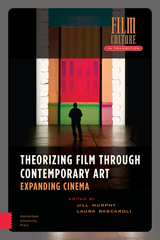 Theorizing Film Through Contemporary Art: Expanding Cinema
Jill Murphy
Amsterdam University Press, 2020 As the cinematic experience becomes subsumed into today's ubiquitous technologies of seeing, contemporary artworks lift the cinematic out of the immateriality of the film screen and separate it into its physical components within the gallery space. How to read these reformulations of the cinematic medium - and their critique of what it is and has been? In Theorizing Cinema Through Contemporary Art: Expanding Cinema, leading film theorists consider artworks that incorporate, restage, and re-present cinema's configuration of the key categories of space, experience, presence/absence, production and consumption, technology, myth, perception, event, and temporality, so interrogating the creation, appraisal, and evolution of film theory as channeled through contemporary art. This book takes film theory as a blueprint for the moving image, and juxtaposes it with artworks that render cinema as a material object. In the process, it unfolds a complex relationship between a theory and a practice that have commonly been seen as virtually incompatible, renewing our understanding of each and, more to the point, their interactions.
Theorizing Global Order: The International, Culture and Governance
Edited by Gunther Hellmann
Campus Verlag, 2018 Despite its prominent place in contemporary political discourse and international relations, the idea of the “global order” remains surprisingly sketchy. Though it’s easy to identify the nations and actors who comprise the major players, but pinning down concrete definitions can be more difficult. This book not only clarifies a number of related key terms—including the use of international versus global and system versus order—but also offers a variety of perspectives for theorizing global order.
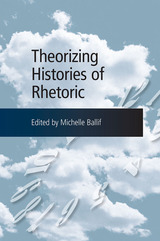 Theorizing Histories of Rhetoric
Edited by Michelle Ballif
Southern Illinois University Press, 2013 During the decades of the 1980s and 1990s, historians of rhetoric, composition, and communication vociferously theorized historiographical motivations and methodologies for writing histories in their fields. After this fertile period of rich, contested, and impassioned theorization, scholars busily undertook the composition of numerous historical works, complicating master narratives and recovering silenced voices and rhetorical practices. Yet, though historians in these fields have gone about the business of writing histories, the discussion of theorization has been quiet. In this welcome volume, fifteen scholars consider, once again, the theory of historiography, asking difficult questions about the purposes and methodologies of writing histories of rhetoric, broadly defined, and questioning what it means, what it should mean, what it could mean to write histories of rhetoric, composition, and communication. The topics addressed include the privileging of the literary and the textual over material artifacts as prime sources of evidence in the study of classical rhetoric, the use of rhetorical hermeneutics as a methodology for interpreting past practices, the investigation of feminist methodologies that do not fit into the dominant modes of feminist historiographical work and the examination of archives with a queer eye to better construct nondiscriminatory narratives. Contributors also explore the value of approaching historiography through the lenses of jazz improvisation and complexity theory, and the historiographical method of writing the future in ways that refigure our relationships to time and to ourselves. Consistently thoughtful and carefully argued, these essays successfully revive the discussion of historiography in rhetoric, inspiring fresh avenues of exploration in the field.
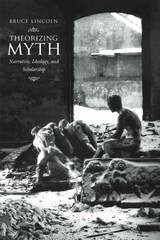 Theorizing Myth: Narrative, Ideology, and Scholarship
Bruce Lincoln
University of Chicago Press, 2000 In Theorizing Myth, Bruce Lincoln traces the way scholars and others have used the category of "myth" to fetishize or deride certain kinds of stories, usually those told by others.
He begins by showing that mythos yielded to logos not as part of a (mythic) "Greek miracle," but as part of struggles over political, linguistic, and epistemological authority occasioned by expanded use of writing and the practice of Athenian democracy. Lincoln then turns his attention to the period when myth was recuperated as a privileged type of narrative, a process he locates in the political and cultural ferment of the eighteenth and nineteenth centuries. Here, he connects renewed enthusiasm for myth to the nexus of Romanticism, nationalism, and Aryan triumphalism, particularly the quest for a language and set of stories on which nation-states could be founded.
In the final section of this wide-ranging book, Lincoln advocates a fresh approach to the study of myth, providing varied case studies to support his view of myth—and scholarship on myth—as ideology in narrative form.
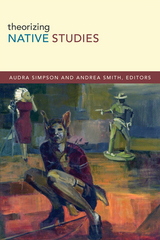 Theorizing Native Studies
Audra Simpson and Andrea Smith, eds.
Duke University Press, 2014 This important collection makes a compelling argument for the importance of theory in Native studies. Within the field, there has been understandable suspicion of theory stemming both from concerns about urgent political issues needing to take precedence over theoretical speculations and from hostility toward theory as an inherently Western, imperialist epistemology. The editors of Theorizing Native Studies take these concerns as the ground for recasting theoretical endeavors as attempts to identify the larger institutional and political structures that enable racism, inequities, and the displacement of indigenous peoples. They emphasize the need for Native people to be recognized as legitimate theorists and for the theoretical work happening outside the academy, in Native activist groups and communities, to be acknowledged. Many of the essays demonstrate how Native studies can productively engage with others seeking to dismantle and decolonize the settler state, including scholars putting theory to use in critical ethnic studies, gender and sexuality studies, and postcolonial studies. Taken together, the essays demonstrate how theory can serve as a decolonizing practice. Contributors. Christopher Bracken, Glen Coulthard, Mishuana Goeman, Dian Million, Scott Morgensen, Robert Nichols, Vera Palmer, Mark Rifkin, Audra Simpson, Andrea Smith, Teresia Teaiwa
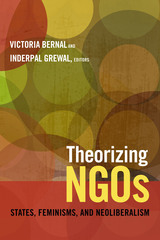 Theorizing NGOs: States, Feminisms, and Neoliberalism
Victoria Bernal and Inderpal Grewal, eds.
Duke University Press, 2014 Theorizing NGOs examines how the rise of nongovernmental organizations (NGOs) has transformed the conditions of women's lives and of feminist organizing. Victoria Bernal and Inderpal Grewal suggest that we can understand the proliferation of NGOs through a focus on the NGO as a unified form despite the enormous variation and diversity contained within that form. Theorizing NGOs brings together cutting-edge feminist research on NGOs from various perspectives and disciplines. Contributors locate NGOs within local and transnational configurations of power, interrogate the relationships of nongovernmental organizations to states and to privatization, and map the complex, ambiguous, and ultimately unstable synergies between feminisms and NGOs. While some of the contributors draw on personal experience with NGOs, others employ regional or national perspectives. Spanning a broad range of issues with which NGOs are engaged, from microcredit and domestic violence to democratization, this groundbreaking collection shows that NGOs are, themselves, fields of gendered struggles over power, resources, and status.
Contributors. Sonia E. Alvarez, Victoria Bernal, LeeRay M. Costa, Inderpal Grewal, Laura Grünberg, Elissa Helms, Julie Hemment, Saida Hodžic, Lamia Karim, Sabine Lang, Lauren Leve, Kathleen O'Reilly, Aradhana Sharma
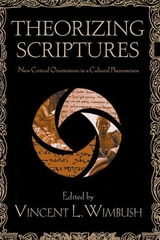 Theorizing Scriptures: New Critical Orientations to a Cultural Phenomenon
Wimbush, Vincent
Rutgers University Press, 2008 Historically, religious scriptures are defined as holy texts that are considered to be beyond the abilities of the layperson to interpret. Their content is most frequently analyzed by clerics who do not question the underlying political or social implications of the text, but use the writing to convey messages to their congregations about how to live a holy existence. In Western society, moreover, what counts as scripture is generally confined to the Judeo-Christian Bible, leaving the voices of minorities, as well as the holy texts of faiths from Africa and Asia, for example, unheard. In this innovative collection of essays that aims to turn the traditional bible-study definition of scriptures on its head, Vincent L. Wimbush leads an in-depth look at the social, cultural, and racial meanings invested in these texts. Contributors hail from a wide array of academic fields and geographic locations and include such noted academics as Susan Harding, Elisabeth Shüssler Fiorenza, and William L. Andrews. Purposefully transgressing disciplinary boundaries, this ambitious book opens the door to different interpretations and critical orientations, and in doing so, allows an ultimately humanist definition of scriptures to emerge.
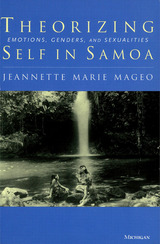 Theorizing Self in Samoa: Emotions, Genders, and Sexualities
Jeannette Marie Mageo
University of Michigan Press, 1998 Theorizing Self in Samoa develops a new theory of the self in culture through a psychological and historical ethnography of Samoa. As in many non-Western cultures, Samoan understandings of the self are more sociocentric--accentuating the social roles that people play--than egocentric--emphasizing individual, interior feelings and perceptions. Yet in Samoa, as in any culture, aspects of the self that are not emphasized in cultural explanations of personhood continually reappear, and must somehow be accounted for. Jeannette Marie Mageo argues that all cultures attempt to encompass these stray experiences of the self within a discursive system. She introduces a way of charting human development through cultural discourses, which helps reveal how emotion, gender, and sexuality are constructed in Samoan society and other cultures, including our own. The second half of the book explores the effects of cultural contact and colonialization on the innermost experience of cultural subjects. With its long ethnographic record, Samoa provides a unique opportunity to consider the dialectic between historical change and personal experience, opening a perspective on the ways in which cultural history is forever leaving its fingerprints upon human lives. Theorizing Self in Samoa marks out important territory for psychological anthropology and students of Oceania, and will appeal also to students and scholars in cultural studies, women's studies, and history. Jeannette Marie Mageo is Associate Professor of Anthropology, Washington State University.
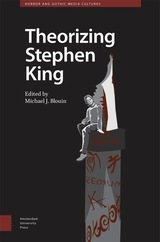 Theorizing Stephen King
Michael Blouin
Amsterdam University Press, 2025 Readers of all stripes will find something to appreciate in this collection, which illuminates how King’s horror literature as a media form has shifted in relation to cultural understandings over time. Many chapters touch upon how surrounding texts, such as film/TV adaptations, have played into these mediations throughout King’s storied career. For the first-time reader of King, this volume offers a doorway into his works: an array of exciting critical frameworks with which to make sense of King’s fictional universe. For literary critics, this volume argues that King’s corpus remains a site for robust intellectual inquiry. And for all of us, the book provides an occasion—one that is long overdue—to rethink King’s relationship to critical theory as well as his legacy as a major American author. While it may prove impossible to reconcile King and the academy, we might nonetheless explore the evolution of their inescapable bond in hopes of negotiating a greater understanding between them.
Theorizing the City: The New Urban Anthropology Reader
Low, Setha M.
Rutgers University Press, 1999 Anthropological perspectives are not often represented in urban studies, even though many anthropologists have been contributing actively to theory and research on urban poverty, racism, globalization, and architecture. The New Urban Anthropology Reader corrects this omission by presenting 12 cross-cultural case studies focusing on the analysis of space and place.
Theory and Craft of the Scenographic Model, Revised Edition
Darwin Reid Payne
Southern Illinois University Press, 1985
Through diagrams, sketches, and models, along with explications of the essential tools and materials required, Payne defines and delineates the precise step-by-step procedures of scenographic modelmaking: the basic preparations of construction, the process of making the model, and the experimental aspects of modelmaking. This new edition with 50 additional illustrations and other new information offers teachers, students, and beginning professionals alike a complete and comprehensive approach to creating and constructing the scenographic model.
Theory and Design of Microwave Filters
Ian Hunter
The Institution of Engineering and Technology, 2001 Microwave filters are vital components in a huge variety of electronic systems, including the rapidly growing communications industry behind mobile radio and satellite communications, as well as radar and other microwave technologies. Ian Hunter provides a graduate-level text that has the aim of enabling the engineer to understand the theory and design of microwave filters.
Theory and Evidence in Semantics
Edited by Erhard W. Hinrichs and John Nerbonne
CSLI, 2009 In Theory and Evidence in Semantics, editors Erhard W. Hinrichs and John Nerbonne present a series of state-of-the-art papers that investigate the interface of natural language semantics with other modules of grammar—such as morphology, syntax, and pragmatics—and pursue applications of semantic theory in computational linguistics. Written by some of the leading scholars in the field, and strongly influenced by the seminal work of David R. Dowty in model-theoretical semantics, the papers provide novel accounts of highly complex sets of semantic phenomena, including anaphora, coordination, ellipsis, interrogatives, and negative and collective predicates, as well as tense and aspect.
Theory and Method In The Neurosciences
Peter Machamer
University of Pittsburgh Press, 2001 Theory and Method in the Neurosciences surveys the nature and structure of theories in contemporary neuroscience, exploring many of its methodological techniques and problems. The essays explore basic questions about how to relate theories of neuroscience and cognition, the multilevel character of such theories, and their experimental bases. Philosophers and scientists (and some who are both) examine the topics of explanation and mechanisms, simulation and computation, imaging and animal models that raise questions about the forefront of research in cognitive neuroscience. Their work will stimulate new thinking in anyone interested in the mind or brain and in recent theories of their connections.
 Theory and Method in the Social Sciences
Arnold M. Rose
University of Minnesota Press, 1954
Theory and Method in the Social Sciences was first published in 1954. Minnesota Archive Editions uses digital technology to make long-unavailable books once again accessible, and are published unaltered from the original University of Minnesota Press editions.
A series of essays dealing with some previously neglected areas of theory and research in the social sciences make up this volume. The problems considered fall into the general categories of social theory, values in social research, the contributions of sociological theory to the other social sciences, methodological issues in sociology, and some specific techniques of sociological research. The chapter entitled "A Theory of Social Organization and Disorganization," published here for the first time, won for Dr. Rose the 1952 prize of the American Association for the Advancement of Science for essays in social science. Although addressed primarily to sociologists, the book offers material of interest and value to other social scientists, particularly economists, psychologists, political scientists, and students of law.
Theory and Methods for Distributed Data Fusion Applications
Felix Govaers
The Institution of Engineering and Technology, 2023 With the rise of digitalization, AI and modern data communication, engineering is increasingly challenged by the complexity of systems-of-systems, in which perception sensors have their own processing mechanism, information is merged at some centric entity, and cross-platform exchange of data is conceptualized in a holistic approach. Therefore, distributed architectures for data fusion, state estimation, and multi target tracking have been becoming increasingly important. The use of multiple sensors to perceive and compute the situational awareness picture leads to the generation of vast amounts of data, which need to be filtered, enriched, interpreted, and evaluated. This becomes infeasible without the notion of distributed algorithms.
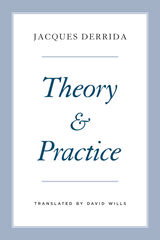 Theory and Practice
Jacques Derrida
University of Chicago Press, 2019 Now in paperback, nine lectures from Jacques Derrida that challenge the influential Marxist distinction between thinking and acting.
Theory and Practice is a series of nine lectures that Jacques Derrida delivered at the École Normale Supérieure in 1976 and 1977. The topic of “theory and practice” was associated above all with Marxist discourse and particularly the influential interpretation of Marx by Louis Althusser. Derrida’s many questions to Althusser and other thinkers aim at unsettling the distinction between thinking and acting.
Derrida’s investigations set out from Marx’s “Theses on Feuerbach,” in particular the eleventh thesis, which has often been taken as a mantra for the “end of philosophy,” to be brought about by Marxist practice. Derrida argues, however, that Althusser has no such end in view and that his discourse remains resolutely philosophical, even as it promotes the theory/practice pair as primary values. This seminar also draws fascinating connections between Marxist thought and Heidegger and features Derrida’s signature reconsideration of the dichotomy between doing and thinking. This text, available for the first time in English, shows that Derrida was doing important work on Marx long before Specters of Marx. As with the other volumes in this series, it gives readers an unparalleled glimpse into Derrida’s thinking at its best—spontaneous, unpredictable, and groundbreaking.
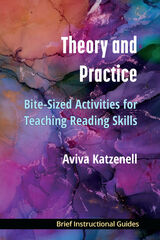 Theory and Practice: Bite-Sized Activities for Teaching Reading Skills
Aviva Katzenell
University of Michigan Press, 2023 Theory and Practice: Bite-Sized Activities for Teaching Reading Skills is an easily digestible guide that links key reading skills theory to practical activities that can be adapted for different classrooms. It dives into the physiological process of reading, the link between sounds and symbols, reading accomplishments at different levels, and the skills required for reading fluency. In addition, Theory and Practice discusses Color Vowel methodology and how it aids students in acquiring automaticity through pattern recognition and associating sound with color. Chapters contain activities for pre-reading, interactive reading, and post-reading as well as how to adapt these activities for different learning levels. Examples of real student work, images, vocabulary logs, and the annotations that accompany each activity demonstrate what teachers can expect for the outcome of each activity. Theory and Practice aims to provide practicing ESOL instructors, student teachers, and educators with the key theory and tools they need to help their classes boost L2 reading skills and cultural competency in English.
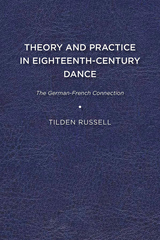 Theory and Practice in Eighteenth-Century Dance: The German-French Connection
Tilden Russell
University of Delaware Press, 2017 This book is about the intersection of two evolving dance-historical realms—theory and practice—during the first two decades of the eighteenth century. France was the source of works on notation, choreography, and repertoire that dominated European dance practice until the 1780s. While these French inventions were welcomed and used in Germany, German dance writers responded by producing an important body of work on dance theory. This book examines consequences in Germany of this asymmetrical confrontation of dance perspectives. Between 1703 and 1717 in Germany, a coherent theory of dance was postulated that called itself dance theory, comprehended why it was a theory, and clearly, rationally distinguished itself from practice. This flowering of dance-theoretical writing was contemporaneous with the appearance of Beauchamps-Feuillet notation in the Chorégraphie of Raoul Auger Feuillet (Paris, 1700, 1701). Beauchamps-Feuillet notation was the ideal written representation of the dance style known as la belle danse and practiced in both the ballroom and the theater. Its publication enabled the spread of belle danse to the French provinces and internationally. This spread encouraged the publication of new practical works (manuals, choreographies, recueils) on how to make steps and how to dance current dances, as well as of new dance treatises, in different languages. The Rechtschaffener Tantzmeister, by Gottfried Taubert (Leipzig, 1717), includes a translated edition of Feuillet’s Chorégraphie. Theory and Practice in Eighteenth-Century Dance addresses how Taubert and his contemporary German authors of dance treatises (Samuel Rudolph Behr, Johann Pasch, Louis Bonin) became familiar with Beauchamps-Feuillet notation and acknowledged the Chorégraphie in their own work, and how Taubert’s translation of the Chorégraphie spread its influence northward and eastward in Europe. This book also examines the personal and literary interrelationships between the German writers on dance between 1703 and 1717 and their invention of a theoria of dance as a counterbalance to dance praxis, comparing their dance-theoretical ideas with those of John Weaver in England, and assimilating them all in a cohesive and inclusive description of dance theory in Europe by 1721.
Published by University of Delaware Press. Distributed worldwide by Rutgers University Press.
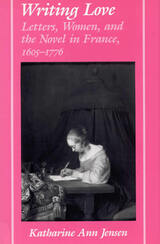 Theory and Practice of American Literary Naturalism: Selected Essay and Reviews
Donald Pizer
Southern Illinois University Press, 1993 In his first book devoted exclusively to naturalism, Donald Pizer brings together thirteen essays and four reviews written over a thirty-year period that in their entirety constitute a full-scale interpretation of the basic character and historical shape of naturalism in America. The essays fall into three groups. Some deal with the full range of American naturalism, from the 1590s to the late twentieth century, and some are confined either to the 1890s or to the twentieth century. In addition to the essays, an introduction in which Pizer recounts the development of his interest in American naturalism, reviews of recent studies of naturalism, and a selected bibliography contribute to an understanding of Pizer’s interpretation of the movement. One of the recurrent themes in the essays is that the interpretation of American naturalism has been hindered by the common view that the movement is characterized by a commitment to Emile Zola’s deterministic beliefs and that naturalistic novels are thus inevitably crude and simplistic both in theme and method. Rather than accept this notion, Pizer insists that naturalistic novels be read closely not for their success or failure in rendering obvious deterministic beliefs but rather for what actually does occur within the dynamic play of theme and form within the work. Adopting this method, Pizer finds that naturalistic fiction often reveals a complex and suggestive mix of older humanistic faiths and more recent doubts about human volition, and that it renders this vital thematic ambivalence in increasingly sophisticated forms as the movement matures. In addition, Pizer demonstrates that American naturalism cannot be viewed monolithically as a school with a common body of belief and value. Rather, each generation of American naturalists, as well as major figures within each generation, has responded to threads within the naturalistic impulse in strikingly distinctive ways. And it is indeed this absence of a rigid doctrinal core and the openness of the movement to individual variation that are responsible for the remarkable vitality and longevity of the movement. Because the essays have their origin in efforts to describe the general characteristics of American naturalism rather than in a desire to cover the field fully, some authors and works are discussed several times (though from different angles) and some referred to only briefly or notat all. But the essays as a collection are "complete" in the sense that they comprise an interpretation of American naturalism both in its various phases and as a whole. Those authors whose works receive substantial discussion include Stephen Crane, Frank Norris, Theodore Dreiser, Edith Wharton, James T. Farrell, Norman Mailer, Joyce Carol Oates, and William Kennedy. Of special interest is Pizer’s essay on Ironweed, which appears here for the first time.
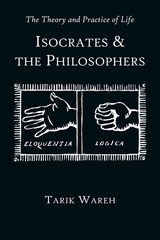 The Theory and Practice of Life: Isocrates and the Philosophers
Tarik Wareh
Harvard University Press, 2012 The Theory and Practice of Life is a study of the literary culture within which the works, schools, and careers of Plato, Aristotle, and contemporary Greek intellectuals took shape. It focuses on the important role played by their rival Isocrates and the rhetorical education offered in his school. Tarik Wareh shows that when Aristotle illustrates his ethical theory by reference to the practical arts, this is no simple appeal to a homespun commonsense analogy, but a sign of dependence on the traditions and concepts of rhetorical and empirical methodology. Likewise, when Plato in the Phaedrus constructs the possibility of a truly philosophical rhetoric on the model of “Hippocratic” medicine, his uncomfortable consciousness of rhetorical theory’s relevance, prestige, and power is revealed. The second half of the book brings together the fragmentary evidence for the participation of “Isocrateans” in the philosophical polemics, princely didactics, and literary competition of the fourth century, shedding new light on the “lost years” of intellectual and literary history that lie before the dawn of the Hellenistic period.
Theory and Practice of Modern Antenna Range Measurements
Clive Parini
The Institution of Engineering and Technology, 2015 This book provides a comprehensive introduction and explanation of both the theory and practice of all forms of modern antenna measurements, from their most basic postulates and assumptions to the intricate details of their application in various demanding modern measurement scenarios.
Theory and Practice of Modern Antenna Range Measurements, Volume 1
Clive Parini
The Institution of Engineering and Technology, 2021 This greatly expanded, co-authored, two-volume text provides a comprehensive introduction and explanation of both the theory and practice of modern antenna measurements, from their most basic postulates and assumptions, to the intricate details of their applications in various demanding modern measurement scenarios.
Theory and Practice of Modern Antenna Range Measurements, Volume 2
Clive Parini
The Institution of Engineering and Technology, 2021 This greatly expanded, co-authored, two-volume text provides a comprehensive introduction and explanation of both the theory and practice of modern antenna measurements, from their most basic postulates and assumptions, to the intricate details of their applications in various demanding modern measurement scenarios.
Theory and Practice of Social Planning
Alfred J. Kahn
Russell Sage Foundation, 1969 Discusses the intellectual processes involved in social planning. Professor Kahn provides critical tools for the analysis of the planning process, and shows what social planning is and can be. Clarifying the major phases in the planning process, he shows how planning can succeed or fail at any one of these stages. He examined planners in their various roles: as "neutral" technicians and as advocates, as representatives of interest groups and as public officials. The book describes both the social aspects of planning and the relationship between social and physical plans.
 Theory and Practice of Sociocriticism: Thl Vol 53
Edmond CrosTranslated by Jerome SchwartzForeword by Jurgen Link and Ursula Link-Heer
University of Minnesota Press, 1988 Theory and Practice of Sociocriticism was first published in 1988. Minnesota Archive Editions uses digital technology to make long-unavailable books once again accessible, and are published unaltered from the original University of Minnesota Press editions. Edmond Cros is a leading French Hispanicist whose work is unique in Continental theory because it brings Spanish and Mexican texts into current literary debates, which have so far centered mainly on the French and German traditions. Equally distinctive is the nature of his work, which Cros terms sociocriticism. Unlike most sociological approaches to literature, which leave the structure of texts untouched, sociocriticism aims to prove that the encounter with "ideological traces," and with antagonistic tensions between social classes, is central to any reading of texts. Cros's method distinguishes between the "semiotic and "ideological" elements within a text, and involves the patient, exacting reconstruction of the concrete text from these elements, a process that enables the sociocritic to interpret its fault lines, its internal contradictions - in the end , its irreducibly social nature. As its title suggests, Theory and Practice of Sociocriticism is structured in two parts. Its opening chapters analyze sociological theories of discourse, including those of Foucault, Bakhtin, and Goldman; in the second part, Cros applies theory to practice in readings of specific works: the film Scarface, contemporary Mexican poetry and prose (Octavio Paz, Carlos Fuentes), and the picaresque novel of the Spanish Golden Age. In their foreword, Jurgen Link and Ursula Link-Heer differentiate sociocriticism from other social approaches to literature and show how Cros's method works in specific textual readings. They emphasize his resistance to the reductive modes and "misreadings" that dominate much of contemporary theory. Edmond Cros is a professor of literary theory and Hispanic studies at the Universite Paul Valery in Montpellier, France, and Andrew W. Mellon Professor of Hispanic Studies at the University of Pittsburgh. Jurgen Link teaches at the Ruhr-Universitat Bochum and Ursula Link-Heer at the Universitat Siegen, both in West Germany.
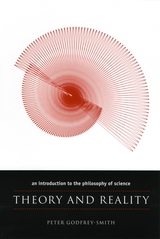 Theory and Reality: An Introduction to the Philosophy of Science
Peter Godfrey-Smith
University of Chicago Press, 2003 How does science work? Does it tell us what the world is "really" like? What makes it different from other ways of understanding the universe? In Theory and Reality, Peter Godfrey-Smith addresses these questions by taking the reader on a grand tour of one hundred years of debate about science. The result is a completely accessible introduction to the main themes of the philosophy of science.
Intended for undergraduates and general readers with no prior background in philosophy, Theory and Reality covers logical positivism; the problems of induction and confirmation; Karl Popper's theory of science; Thomas Kuhn and "scientific revolutions"; the views of Imre Lakatos, Larry Laudan, and Paul Feyerabend; and challenges to the field from sociology of science, feminism, and science studies. The book then looks in more detail at some specific problems and theories, including scientific realism, the theory-ladeness of observation, scientific explanation, and Bayesianism. Finally, Godfrey-Smith defends a form of philosophical naturalism as the best way to solve the main problems in the field.
Throughout the text he points out connections between philosophical debates and wider discussions about science in recent decades, such as the infamous "science wars." Examples and asides engage the beginning student; a glossary of terms explains key concepts; and suggestions for further reading are included at the end of each chapter. However, this is a textbook that doesn't feel like a textbook because it captures the historical drama of changes in how science has been conceived over the last one hundred years.
Like no other text in this field, Theory and Reality combines a survey of recent history of the philosophy of science with current key debates in language that any beginning scholar or critical reader can follow.
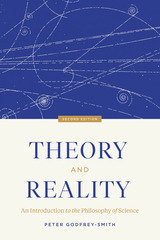 Theory and Reality: An Introduction to the Philosophy of Science, Second Edition
Peter Godfrey-Smith
University of Chicago Press, 2021 How does science work? Does it tell us what the world is “really” like? What makes it different from other ways of understanding the universe? In Theory and Reality, Peter Godfrey-Smith addresses these questions by taking the reader on a grand tour of more than a hundred years of debate about science. The result is a completely accessible introduction to the main themes of the philosophy of science. Examples and asides engage the beginning student, a glossary of terms explains key concepts, and suggestions for further reading are included at the end of each chapter.
Like no other text in this field, Theory and Reality combines a survey of recent history of the philosophy of science with current key debates that any beginning scholar or critical reader can follow. The second edition is thoroughly updated and expanded by the author with a new chapter on truth, simplicity, and models in science.
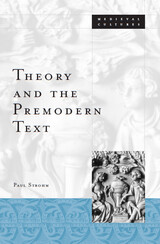 Theory And The Premodern Text
Paul Strohm
University of Minnesota Press, 2000 A major reconsideration of relations between new theories and old texts. Medieval Studies/Literary Theory A major reconsideration of relations between new theories and old texts. The work of Paul Strohm allies the most distinguished traditions of medieval study with the most challenging and innovative of theoretical approaches. These features, working together to revise and expand our understanding of both medieval texts and contemporary critical practice, are apparent in full and compelling force in this collection of essays, most now in print for the first time. In a range of theoretical engagements with late medieval texts, dealing with social practice, time, and narrative, this volume proposes a "practical" relation between the text and the theory that illuminates it.Insisting on the imaginative multiplicity of the text, Strohm finds in theory an augmentation of interpretive possibilities-an augmentation that sometimes requires respectful disagreement with what a work says-or seems to want known-about itself. He thus defines theory as "any standpoint from which we might challenge a text’s self-understanding." Coupled with this strategic disrespect is a new and amplified form of respect-for the text as a meaning-making system, for its unruly power and its unpredictable effects in the world.In this spirit, Strohm offers new and illustrative readings of Hoccleve’s "Male Regle" and Regiment of Princes, Ricardian coronation documents, Chaucer’s "Cook’s Tale," Capgrave’s chronicle, the Gesta Henrici Quinti, records of the king’s bench, Malory’s "Knight of the Cart," and other later medieval texts. Throughout, Strohm traverses categories of "literary" and "non-literary" in the service of a more comprehensive understanding of texts and the resourcefulness with which they accomplish their social work.Medieval Cultures Series, volume 26Translation Inquiries: University of Minnesota Press
 Theory as Practice: A Critical Anthology of Early German Romantic Writings
Jochen Schulte-Sasse, Haynes Horne, Elizabeth Mittman, Lisa C. Roetzel, Andreas Michel, Assenka Oksiloff, and Mary R. Strand, EditorsTranslated by Jochen Schulte-Sasse
University of Minnesota Press, 1997 Theory as Practice was first published in 1997. Minnesota Archive Editions uses digital technology to make long-unavailable books once again accessible, and are published unaltered from the original University of Minnesota Press editions. In light of recent, dramatic revisions in criticism of European-particularly German-Romanticism, this anthology brings together key texts of the movement, especially those written in the last quarter of the eighteenth century by a small, influential circle centered at Jena. In their introductory essays, the editors locate writings by Fichte, Schelling, Novalis, August Wilhelm Schlegel, and Friedrich Schlegel, among others, in this context. The selections include extensive excerpts from the correspondence of the Jena Romantics, their commentaries on each other's work, their most pertinent essays, fragments, and dialogues as well as diary entries and reviews. These works, together with the editors' articulation and elaboration of their significance, provide a new perspective on the provenance of postmodern thought and literary theory. Jochen Schulte-Sasse is professor of German and comparative literature at the University of Minnesota and coeditor (with Wlad Godzich) of the Theory and History of Literature series at the University of Minnesota Press. Haynes Horne (University of Alabama), Andreas Michel (Indiana University), Assenka Oksiloff (New York University), Elizabeth Mittman (Michigan State University), Lisa C. Roetzel (University of Rochester), and Mary R. Strand each received a Ph.D. from the University of Minnesota.
 Theory as Practice: Ethical Inquiry in the Renaissance
Nancy S. Struever
University of Chicago Press, 1992 There is a tendency in modern scholarship to describe the Renaissance Humanists merely as readers—as interpreters happily absorbed within the bounds of their chosen classical texts. In Theory as Practice, Nancy Struever contests this accepted notion; by focusing on ethical inquiry, she presents the Humanists as engaged in subtle, innovative moral work.
Struever argues that the accomplishment of five major Renaissance figures—Petrarch, Nicolaus Cusanus, Lorenzo Valla, Machiavelli, and Montaigne—was to consider theory as practice and thus engage the ethics of inquiry. She notes three stages of investigation, the first represented by Petrarch, who "relocated" ethical inquiry from a theoretical realm to a familiar practice responsive to daily experience. Next, Struever describes how Cusanus and Valla assume Petrarch's relocation, yet confect ethics into discursive disciplines. Finally, while both Machiavelli and Montaigne produced strong revisions of discipline, they considered the problems of addressing the non-inquirer as well. Struever urges modern readers to employ both rhetorical and philosophical analysis to reveal these Humanists' aggressive tactics of presentation as well as their novel disciplinary reorientation. By doing so, she suggests, we discover how Renaissance ethical inquiry illuminates, and is illuminated by, the modern ethical theory of such philosophers as Peirce, Wittgenstein, Bernard Williams, and Quine.
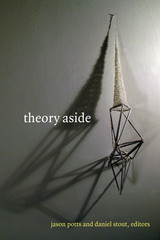 Theory Aside
Jason Potts and Daniel Stout, eds.
Duke University Press, 2014 Where can theory go now? Where other voices concern themselves with theory's life or death, the contributors to Theory Aside take up another possibility: that our theoretical prospects are better served worrying less about "what’s next?" and more about "what else?" Instead of looking for the next big thing, the fourteen prominent thinkers in this volume take up lines of thought lost or overlooked during theory's canonization. They demonstrate that intellectual progress need not depend on the discovery of a new theorist or theory. Moving subtly through a diverse range of thinkers and topics—aesthetics, affect, animation and film studies, bibliography, cognitive science, globalization, phenomenology, poetics, political and postcolonial theory, race and identity, queer theory, and sociological reading practices—the contributors show that a more sustained, less apocalyptic attention to ideas might lead to a richer discussion of our intellectual landscapes and the place of the humanities and social sciences in it. In their turn away from the radically new, these essays reveal that what’s fallen aside still surprises.
Contributors. Ian Balfour, Karen Beckman, Pheng Cheah, Frances Ferguson, William Flesch, Anne-Lise François, Mark B. N. Hansen, Simon Jarvis, Heather Love, Natalie Melas, Jason Potts, Elizabeth A. Povinelli, Eve Kosofsky Sedgwick, Jordan Alexander Stein, Daniel Stout, Irene Tucker
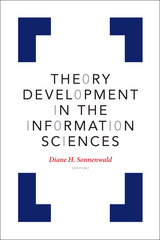 Theory Development in the Information Sciences
Edited by Diane H. Sonnenwald
University of Texas Press, 2016 Emerging as a discipline in the first half of the twentieth century, the information sciences study how people, groups, organizations, and governments create, share, disseminate, manage, search, access, evaluate, and protect information, as well as how different technologies and policies can facilitate and constrain these activities. Given the broad span of the information sciences, it is perhaps not surprising that there is no consensus regarding its underlying theory—the purposes of it, the types of it, or how one goes about developing new theories to talk about new research questions. Diane H. Sonnenwald and the contributors to this volume seek to shed light on these issues by sharing reflections on the theory-development process. These reflections are not meant to revolve around data collection and analysis; rather, they focus on the struggles, challenges, successes, and excitement of developing theories. The particular theories that the contributors explore in their essays range widely, from theories of literacy and reading to theories of design and digital search. Several chapters engage with theories of the behavior of individuals and groups; some deal with processes of evaluation; others reflect on questions of design; and the rest treat cultural and scientific heritage. The ultimate goal, Sonnenwald writes in her introduction, is to “encourage, inspire, and assist individuals striving to develop and/or teach theory development.”
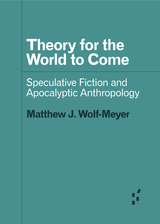 Theory for the World to Come: Speculative Fiction and Apocalyptic Anthropology
Matthew J. Wolf-Meyer
University of Minnesota Press, 2019 Can social theories forge new paths into an uncertain future?
The future has become increasingly difficult to imagine. We might be able to predict a few events, but imagining how looming disasters will coincide is simultaneously necessary and impossible. Drawing on speculative fiction and social theory, Theory for the World to Come is the beginning of a conversation about theories that move beyond nihilistic conceptions of the capitalism-caused Anthropocene and toward generative bodies of thought that provoke creative ways of thinking about the world ahead. Matthew J. Wolf-Meyer draws on such authors as Kim Stanley Robinson and Octavia Butler, and engages with afrofuturism, indigenous speculative fiction, and films from the 1970s and ’80s to help think differently about the future and its possibilities.
Forerunners: Ideas First
Short books of thought-in-process scholarship, where intense analysis, questioning, and speculation take the lead
Theory in the Practice of the Nicaraguan Revolution
Bruce E. Wright
Ohio University Press, 1995 Even in the period following the electoral defeat of the Sandinista National Liberation Front (FSLN) in 1990, the revolution of 1979 continues to have a profound effect on the political economy of Nicaragua. Wright’s study, which is based on interviews with people from all walks of life—from government and party officials to academics and campesinos—as well as on the large volume of literature in both English and Spanish, focuses on the FSLN understanding of the relationships between the state, the party, and mass actors, and the nature of social classes. Wright considers the topics of agrarian reform, the development of mass organizations, the role of labor, and other aspects of the Nicaraguan political economy in order to assess their significance in theoretical as well as practical terms.
Theory Now and Then
J. Hillis Miller
Duke University Press, 1991 Theory Now and Then contains the more overtly theoretical essays by J. Hillis Miller published between 1966 and 1989. These essays trace the trajectory of theory over the last thirty years in the United States: from the “Continental Shift” announced in the Yale Colloquium of 1965, through Miller’s assimilation of the work of the Geneva Critics, to the shift to that “deconstruction in America” in which Miller played a conspicuous role.
Included here are review essays on other theorists’ work: the Geneva Circle including Georges Poulet; Joseph Riddel, Edward Said, Meyer Abrams; and the critics of the “Yale School,” such as Jacques Derrida and others, Paul De Man, Geoffrey Hartman, and Harold Bloom, with whom Miller was associated. Exemplary readings of the theorists themselves, and of texts by Milton, Shelley, Wordsworth, Emerson, George Eliot, Nietzsche, Wallace Stevens, and William Carlos Williams punctuate these essays.
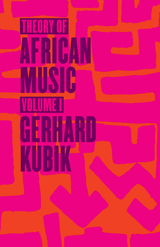 Theory of African Music, Volume I
Gerhard Kubik
University of Chicago Press, 2010 Taken together, these comprehensive volumes offer an authoritative account of the music of Africa. One of the most prominent experts on the subject, Gerhard Kubik draws on his extensive travels and three decades of study in many parts of the continent to compare and contrast a wealth of musical traditions from a range of cultures.
In the first volume, Kubik describes and examines xylophone playing in southern Uganda and harp music from the Central African Republic; compares multi-part singing from across the continent; and explores movement and sound in eastern Angola. And in the second volume, he turns to the cognitive study of African rhythm, Yoruba chantefables, the musical Kachamba family of Malaŵi, and African conceptions of space and time.
Each volume features an extensive number of photographs and is accompanied by a compact disc of Kubik’s own recordings. Erudite and exhaustive, Theory of African Music will be an invaluable reference for years to come.
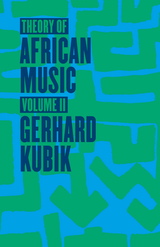 Theory of African Music, Volume II
Gerhard Kubik
University of Chicago Press, 2010 Erudite and exhaustive, Gerhard Kubik’s Theory of African Music provides an authoritative account of its subject. Over the course of two volumes, Kubik, one of the most prominent experts in the field, draws on his extensive travels and three decades of study throughout Africa to compare and contrast a wealth of musical traditions from a range of cultures.
In this second volume, Kubik explores a variety of topics, including Yoruba chantefables, the musical Kachamba family of Malawˆ i, and the cognitive study of African rhythm. Drawing on his remarkable ability to make cross-cultural comparisons, Kubik illuminates every facet of the African understanding of rhythm, from timing systems to elementary pulsation. His analysis of tusona ideographs in Luchazi culture leads to an exploration of African space/time concepts that synthesizes his theories of art, rhythm, and culture.
Featuring a large number of photographs and accompanied by a compact disc of Kubik’s own recordings, Theory of African Music, Volume II, will be an invaluable reference for years to come.
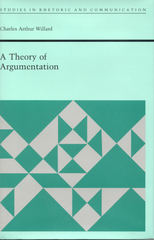 A Theory of Argumentation
Charles Arthur Willard
University of Alabama Press, 1989 Establishes a theoretical context for, and to elaborate the implications of, the claim that argument is a form of interaction in which two or more people maintain what they construe to be incompatible positions
The thesis of this book is that argument is not a kind of logic but a kind of communication—conversation based on disagreement. Claims about the epistemic and political effects of argument get their authority not from logic but from their “fit with the facts” about how communication works. A Theory of Communication thus offers a picture of communication—distilled from elements of symbolic interactionism, personal construct theory, constructivism, and Barbara O’Keefe’s provocative thinking about logics of message design. The picture of argument that emerges from this tapestry is startling, for it forces revisions in thinking about knowledge, rationality, freedom, fallacies, and the structure and content of the argumentation discipline.
 A Theory of Assembly: From Museums to Memes
Kyle Parry
University of Minnesota Press, 2022 A vital reckoning with how we understand the basic categories of cultural expression in the digital era
Digital and social media have transformed how much and how fast we communicate, but they have also altered the palette of expressive strategies: the cultural forms that shape how citizens, activists, and artists speak and interact. Most familiar among these strategies are storytelling and representation. In A Theory of Assembly, Kyle Parry argues that one of the most powerful and pervasive cultural forms in the digital era is assembly. Whether as subtle photographic sequences, satirical Venn diagrams, or networked archives, projects based in assembly do not so much narrate or represent the world as rearrange it. This work of rearranging can take place at any scale, from a simple pairing of images, undertaken by one person, to the entire history of internet memes, undertaken by millions. With examples ranging from GIFs and paintings to museum exhibitions and social movement hashtags, Parry shows how, in the internet age, assembly has come to equal narrative and representation in its reach and influence, particularly as a response to ecological and social violence. He also emphasizes the ambivalence of assembly—the way it can be both emancipatory and antidemocratic. As the world becomes ever hotter, more connected, and more algorithmic, the need to map—and remake—assembly’s powers and perils becomes all the more pressing. Interdisciplinary, engaging, and experimental, A Theory of Assembly serves as a playbook of strategies and critical frameworks for artists, activists, and content creators committed to social and environmental justice, ultimately arguing for a collective reenvisioning of which cultural forms matter. Cover alt text: Letters from the title appear in a jumble, each colored in a blue-orange gradient. Readable title and author sits below the jumble.
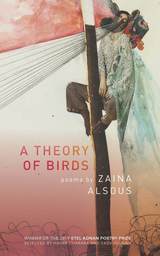 A Theory of Birds: Poems
Zaina Alsous
University of Arkansas Press, 2019 Winner of the 2019 Etel Adnan Poetry Prize
Inside the dodo bird is a forest, Inside the forest
a peach analog, Inside the peach analog a woman, Inside
the woman a lake of funerals This layering of bird, woman, place, technology, and ceremony, which begins this first full-length collection by Zaina Alsous, mirrors the layering of insights that marks the collection as a whole. The poems in A Theory of Birds draw on inherited memory, historical record, critical theory, alternative geographies, and sharp observation. In them, birds—particularly extinct species—become metaphor for the violences perpetrated on othered bodies under the colonial gaze. Putting ecological preservation in conversation with Arab racial formation, state vernacular with the chatter of birds, Alsous explores how categorization can be a tool for detachment, domination, and erasure. Stretching their wings toward de-erasure, these poems—their subjects and their logics—refuse to stay put within a single category. This is poetry in support of a decolonized mind.
|
|
